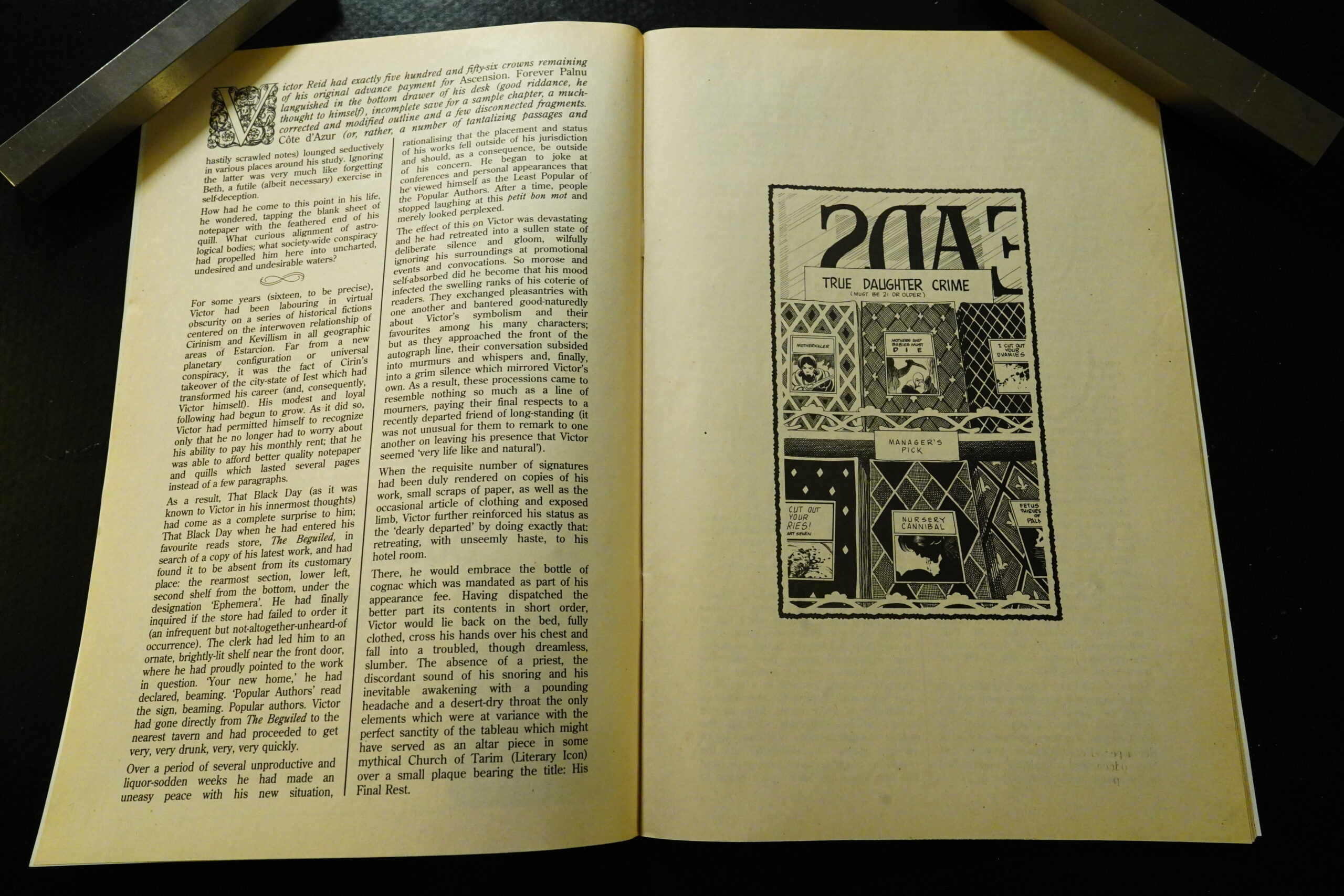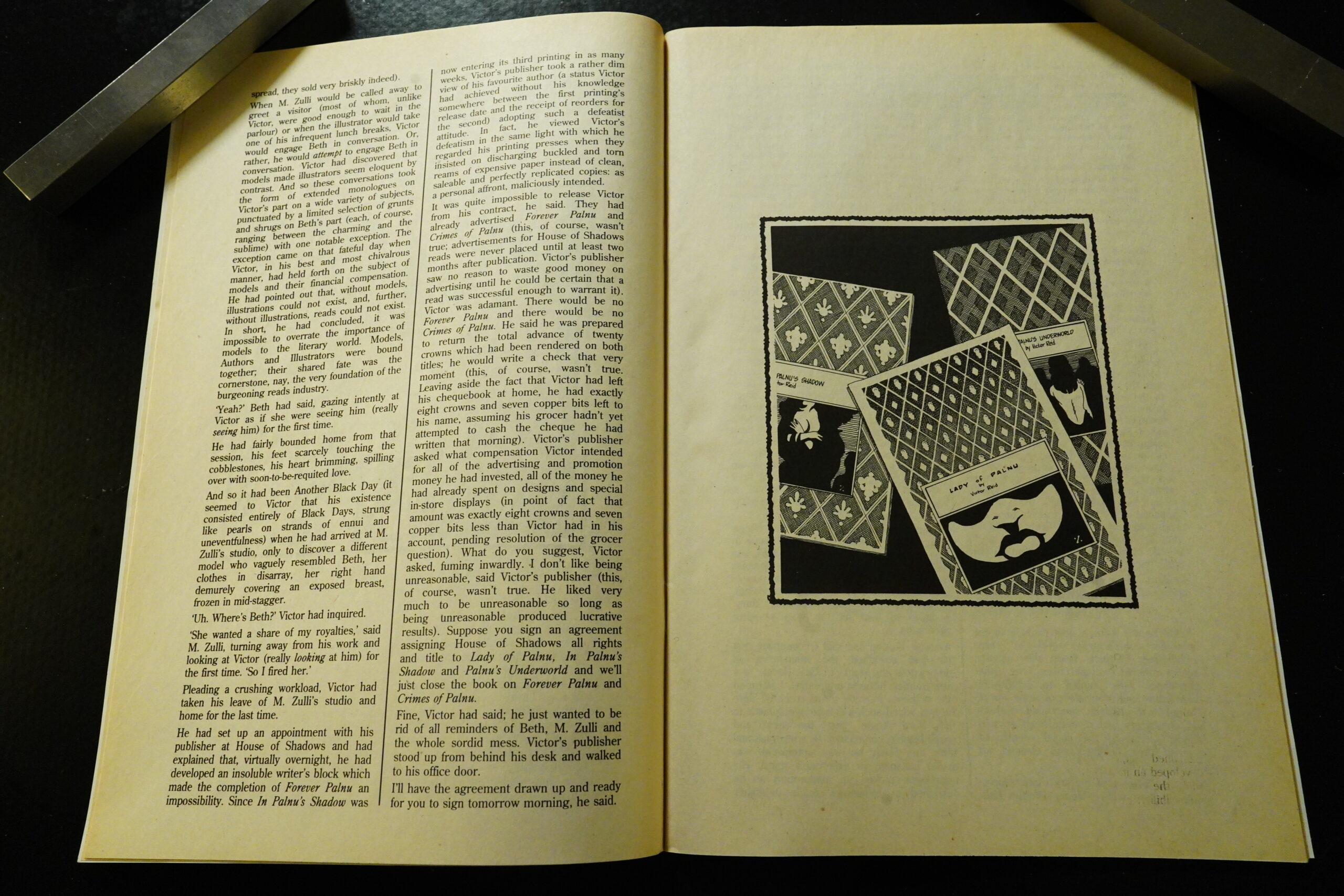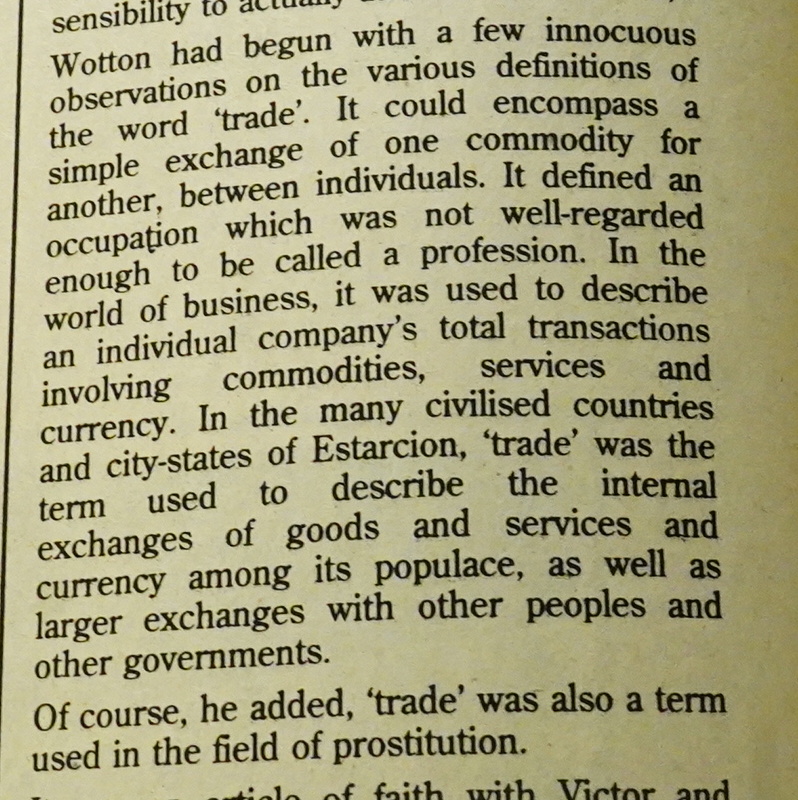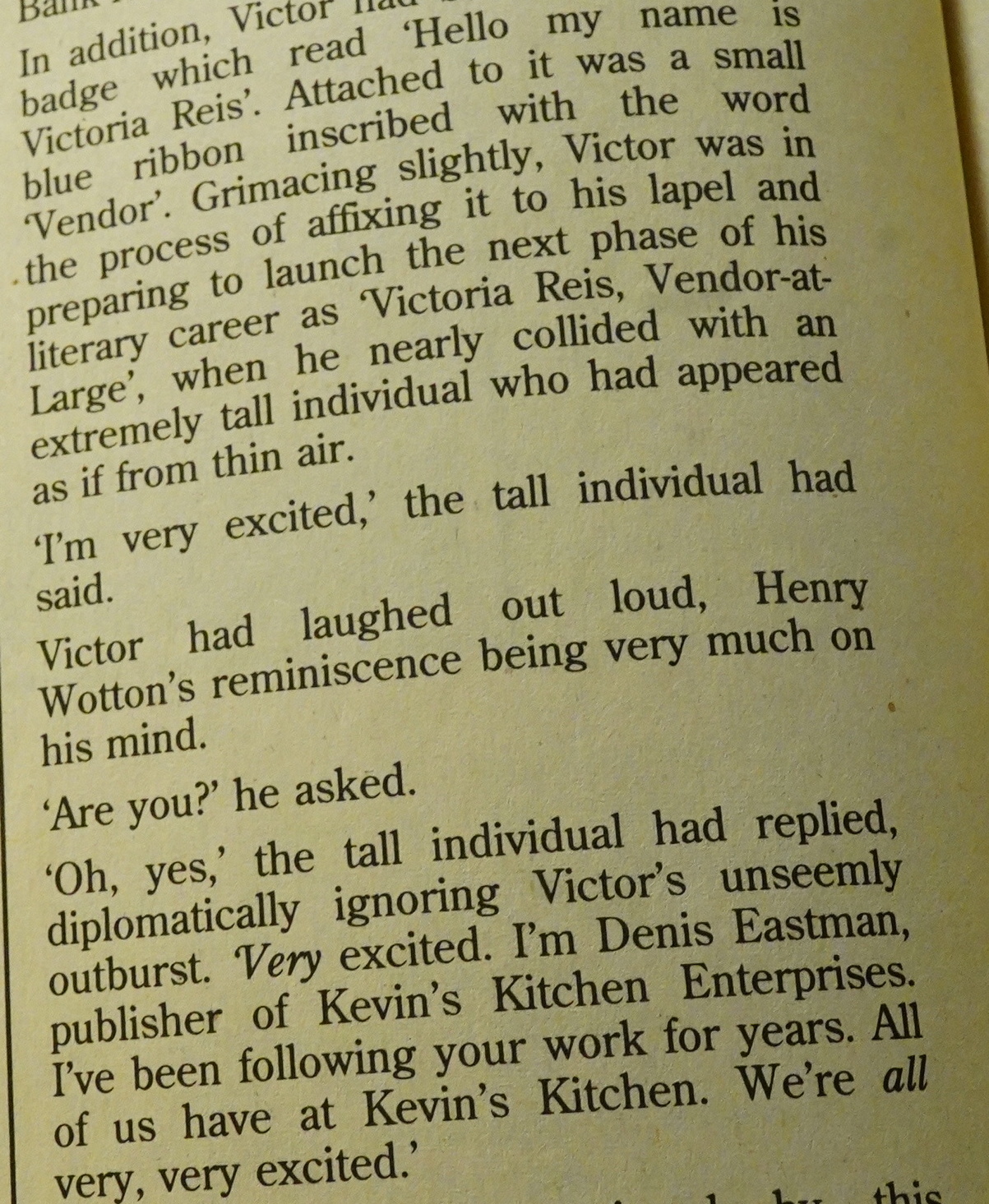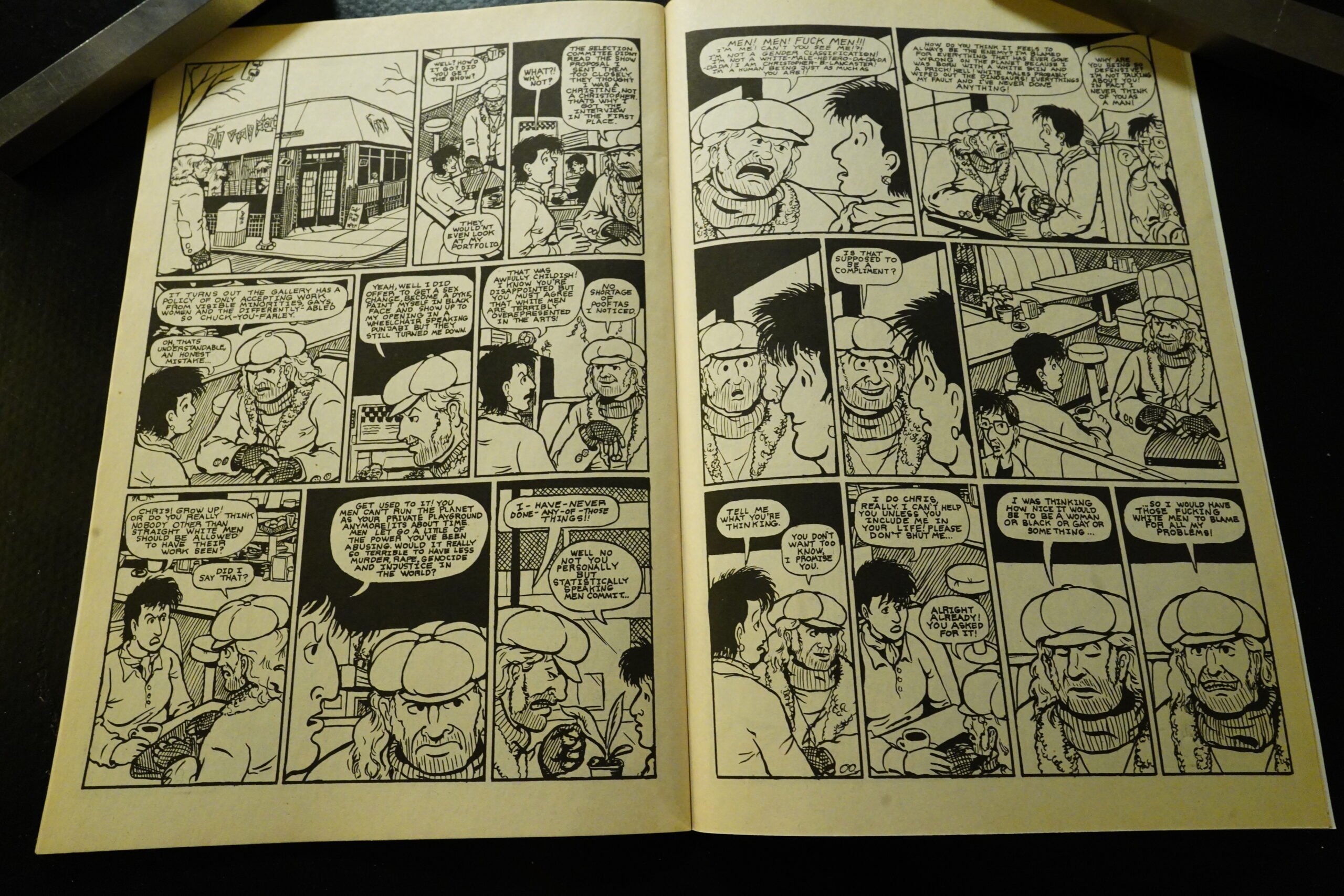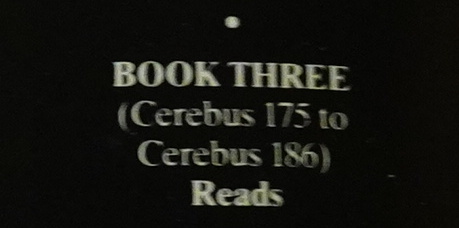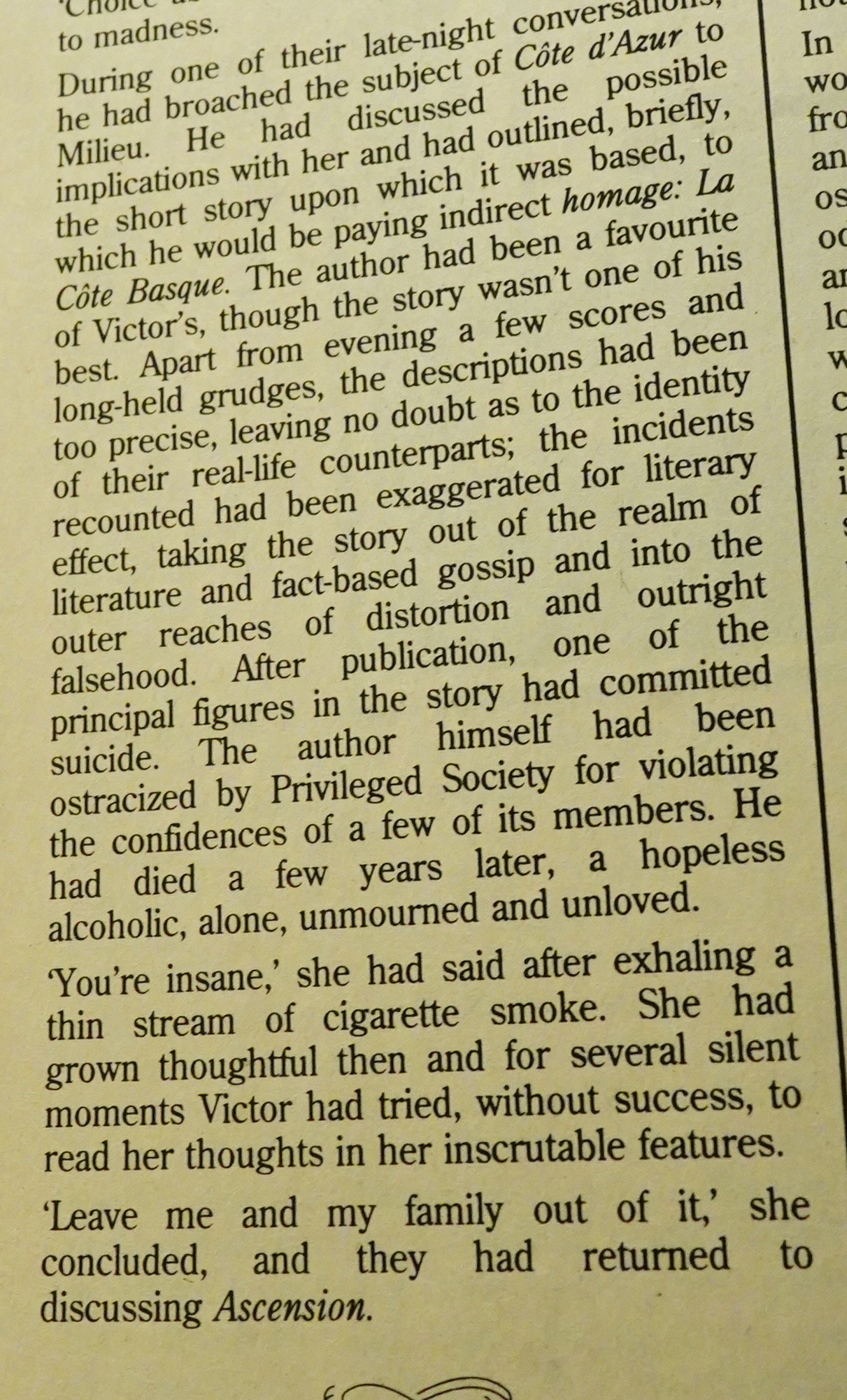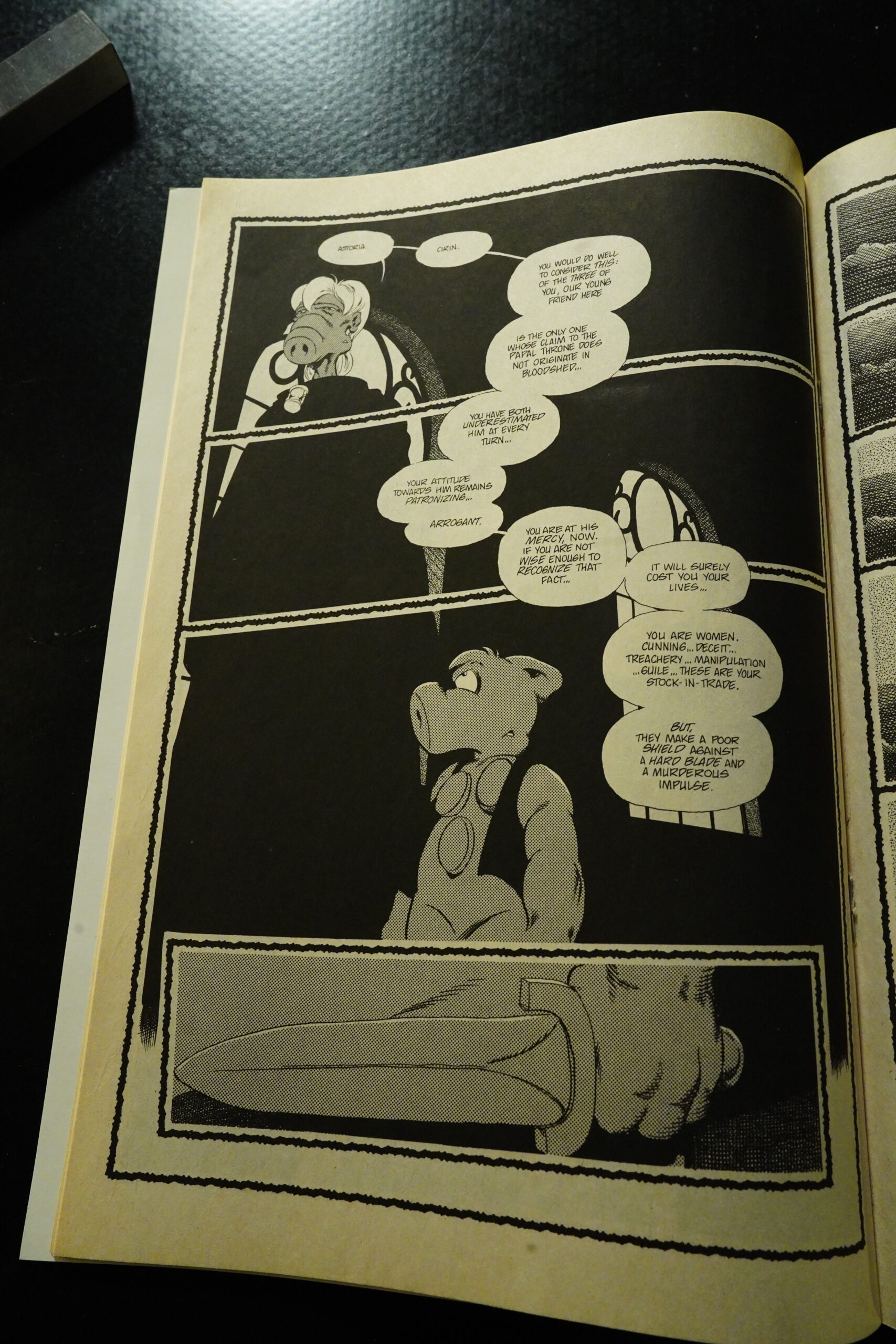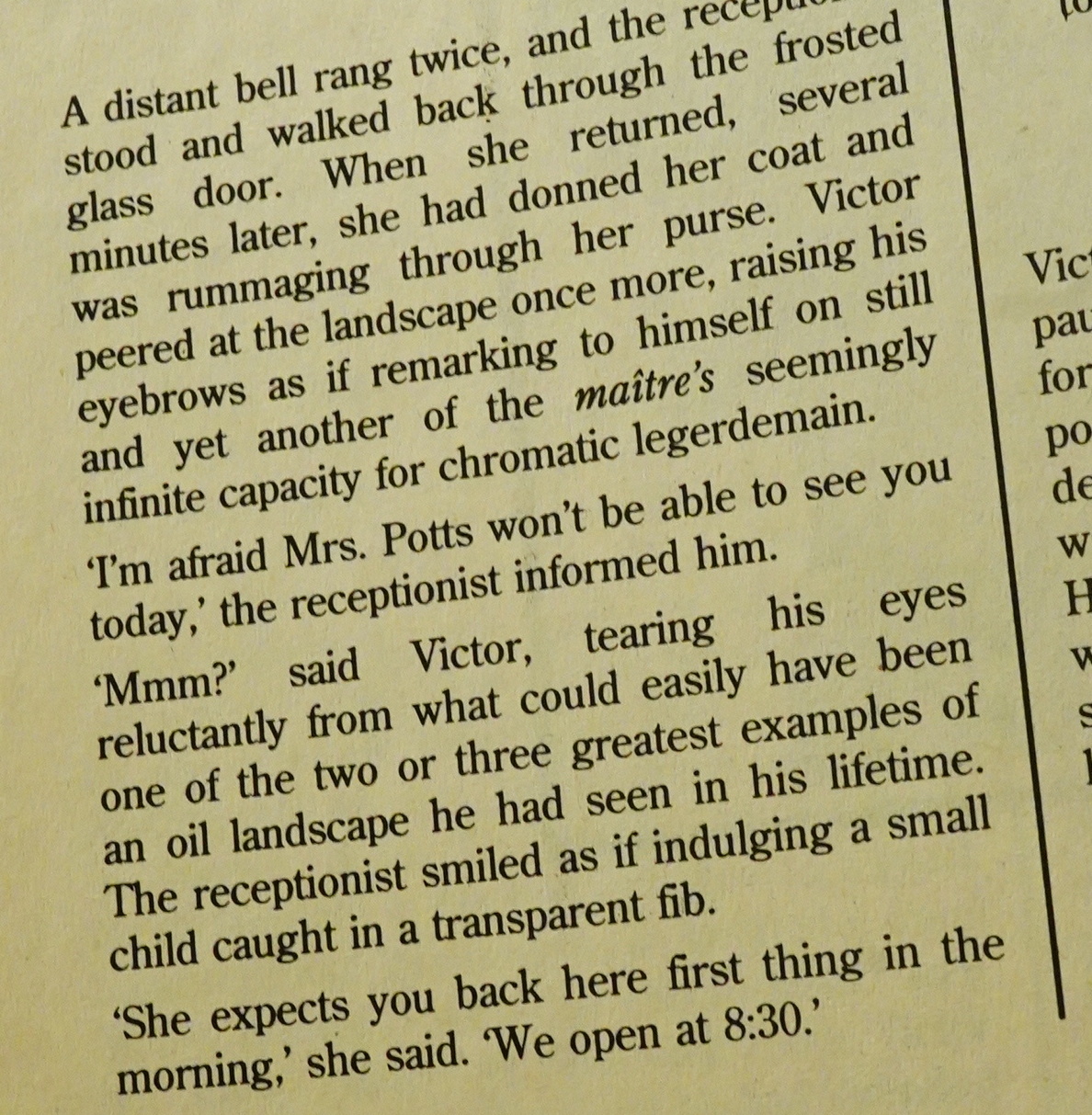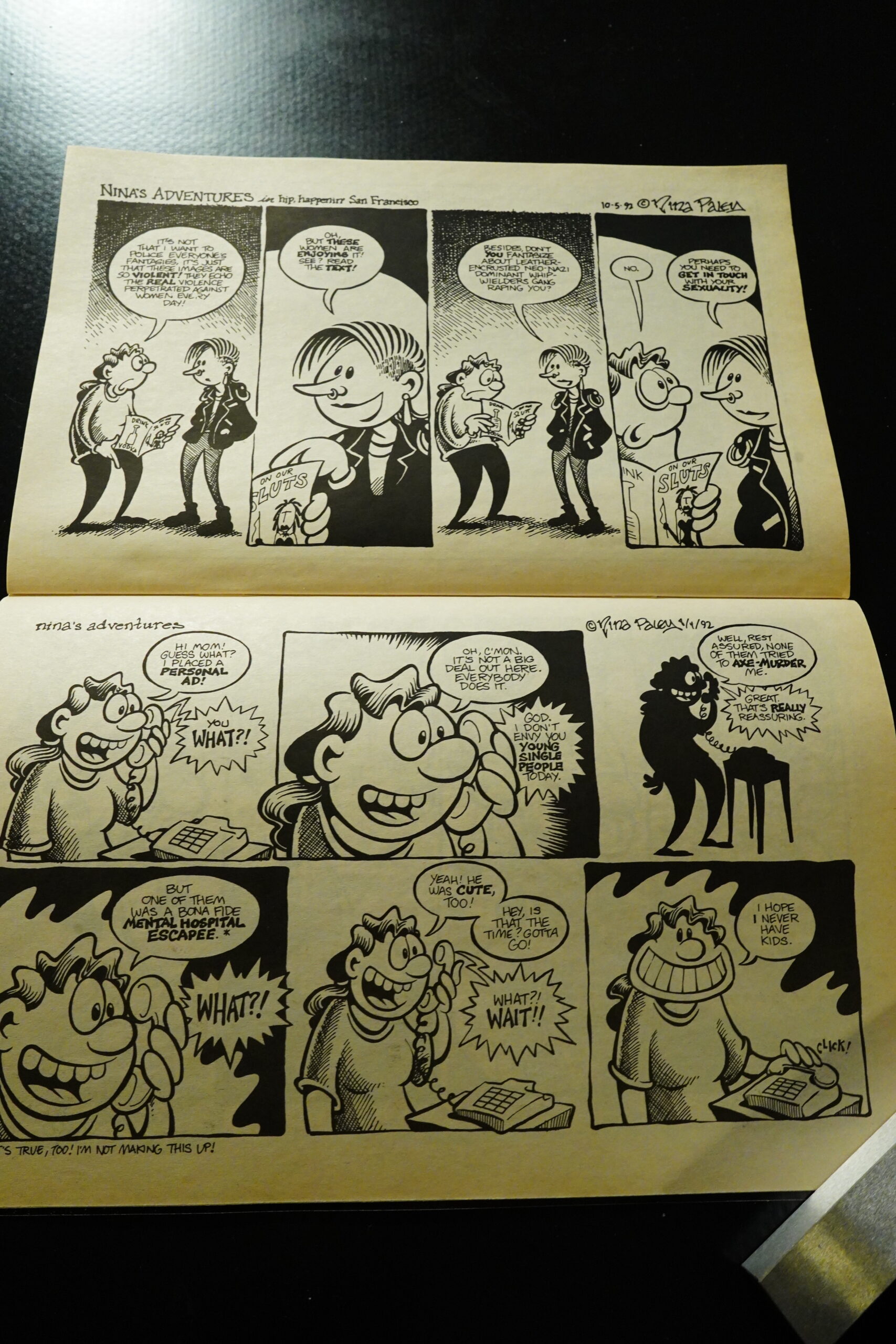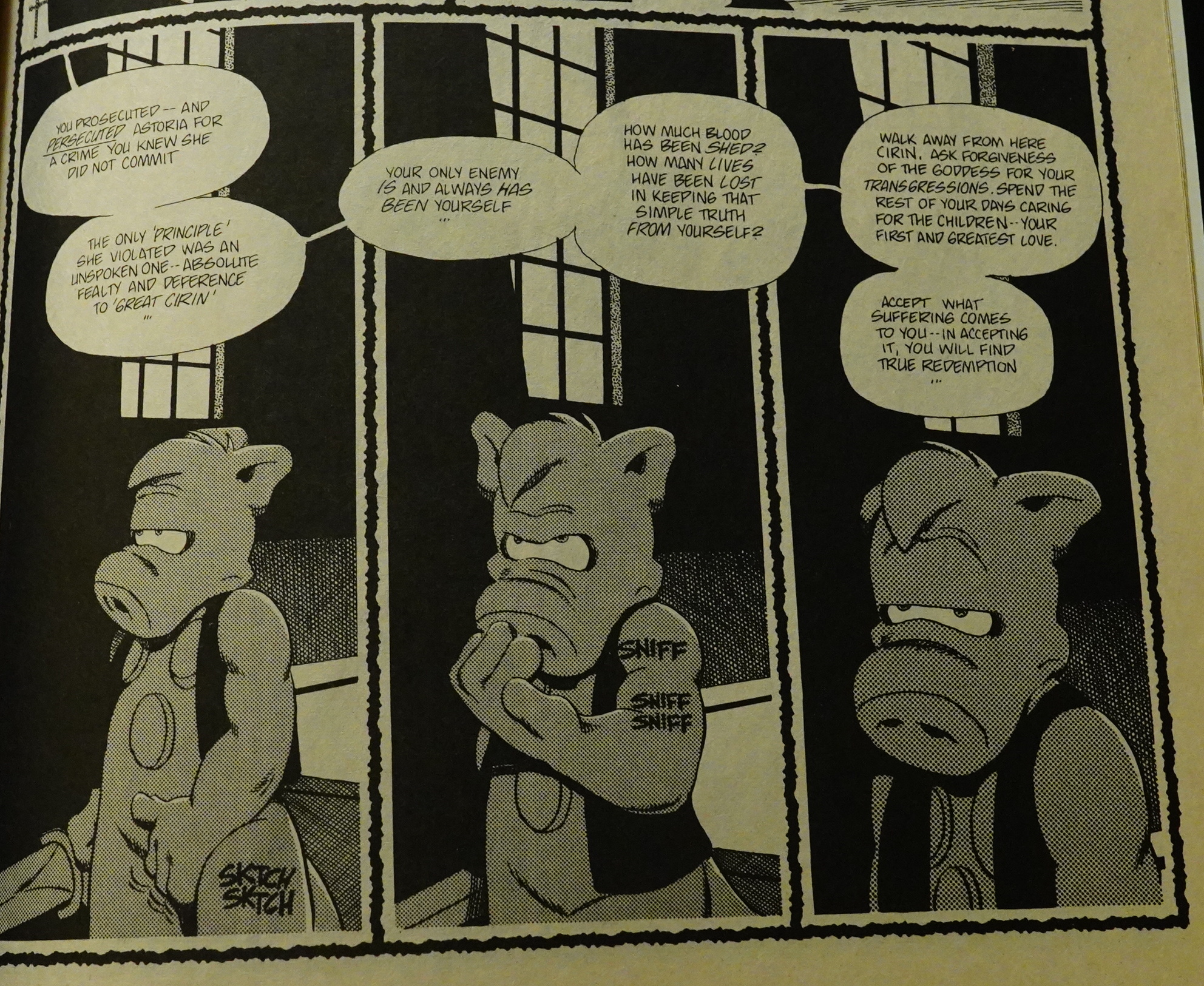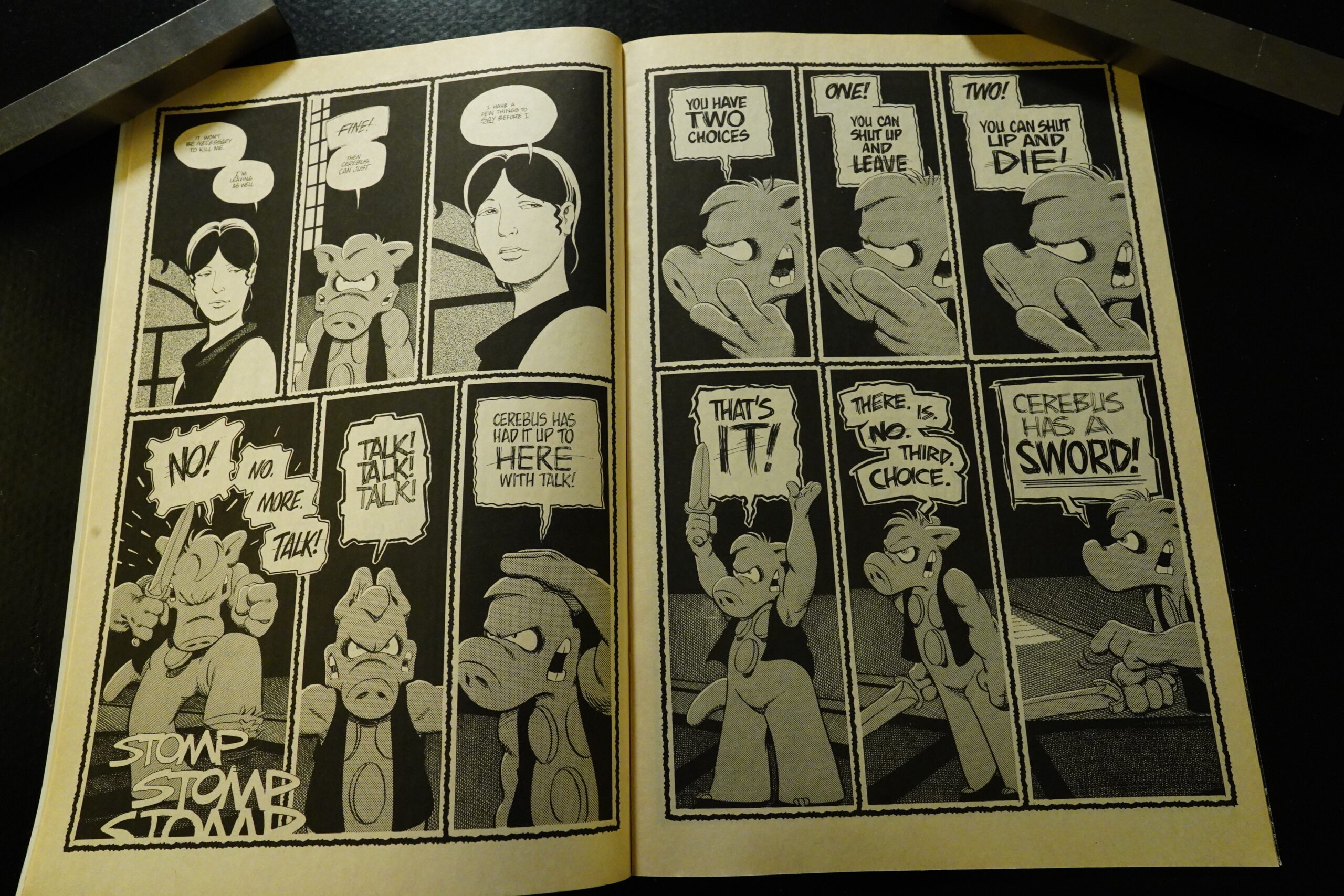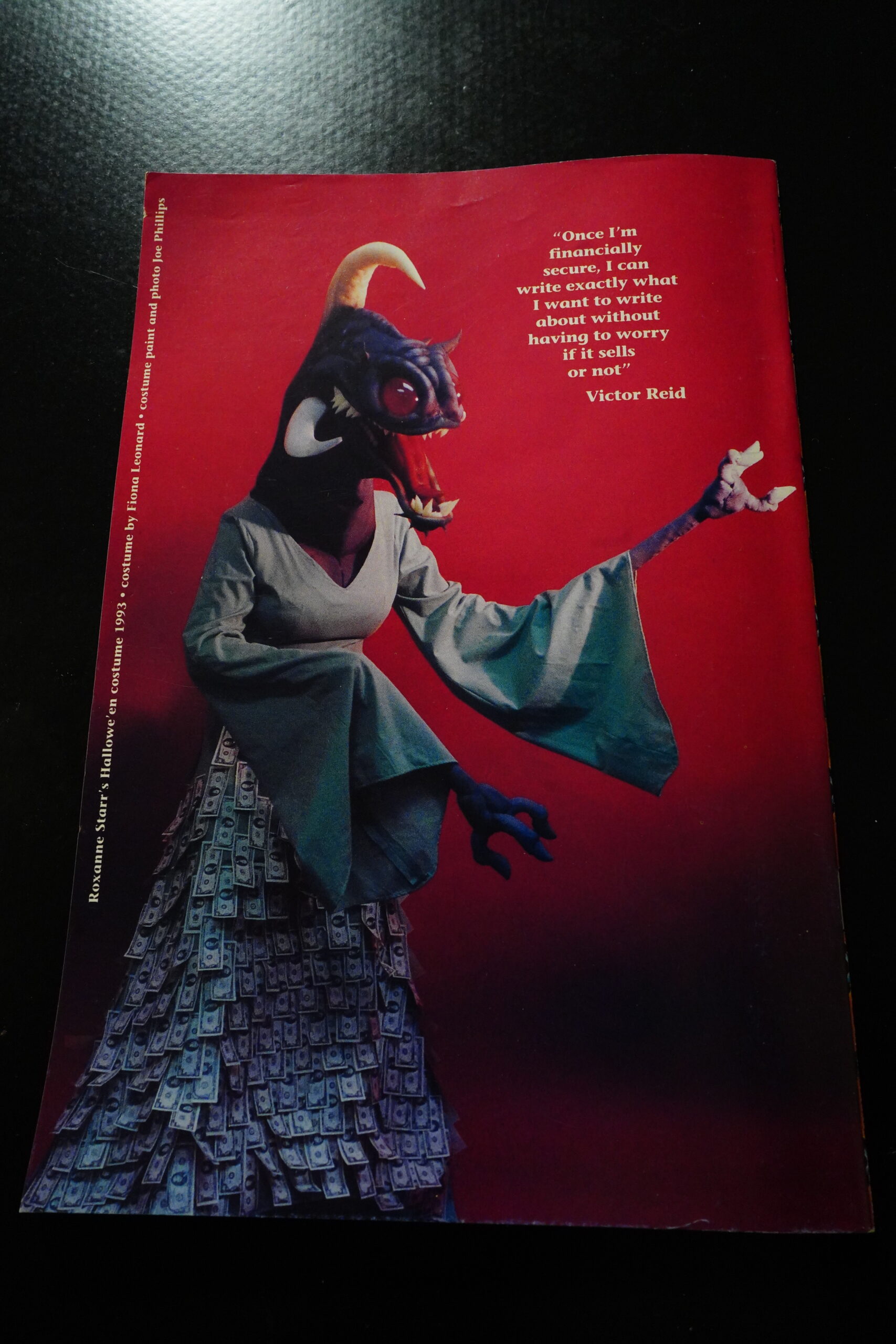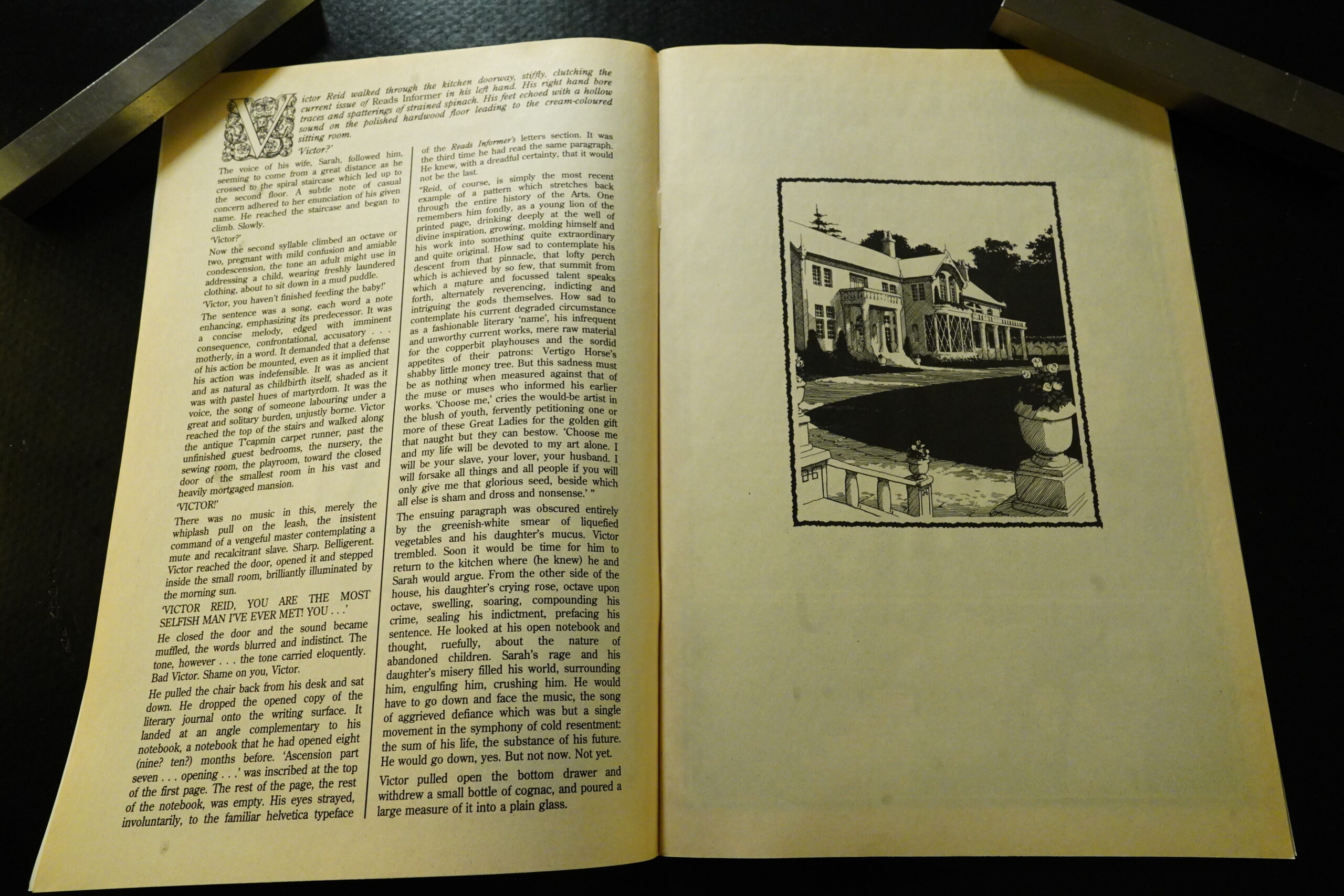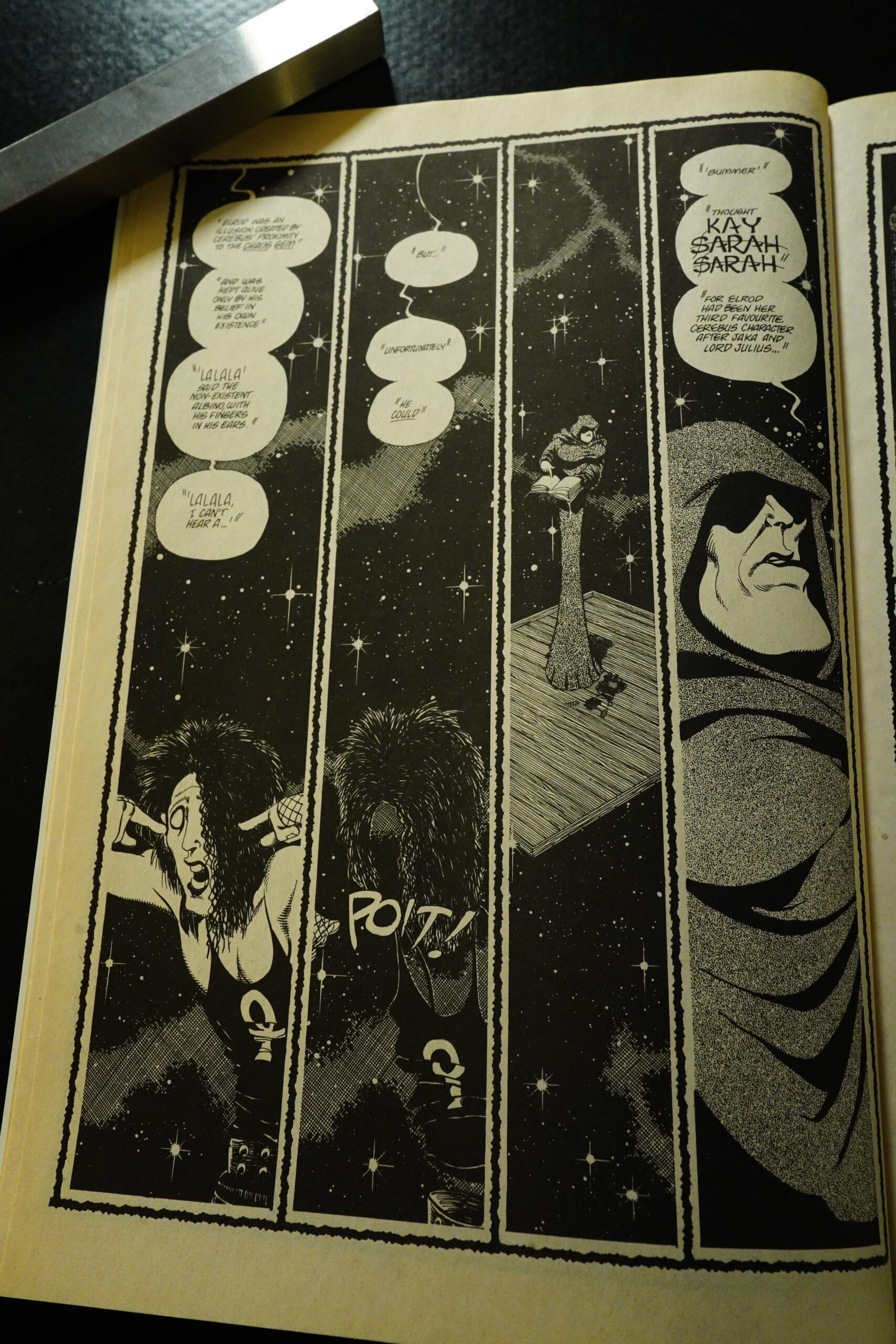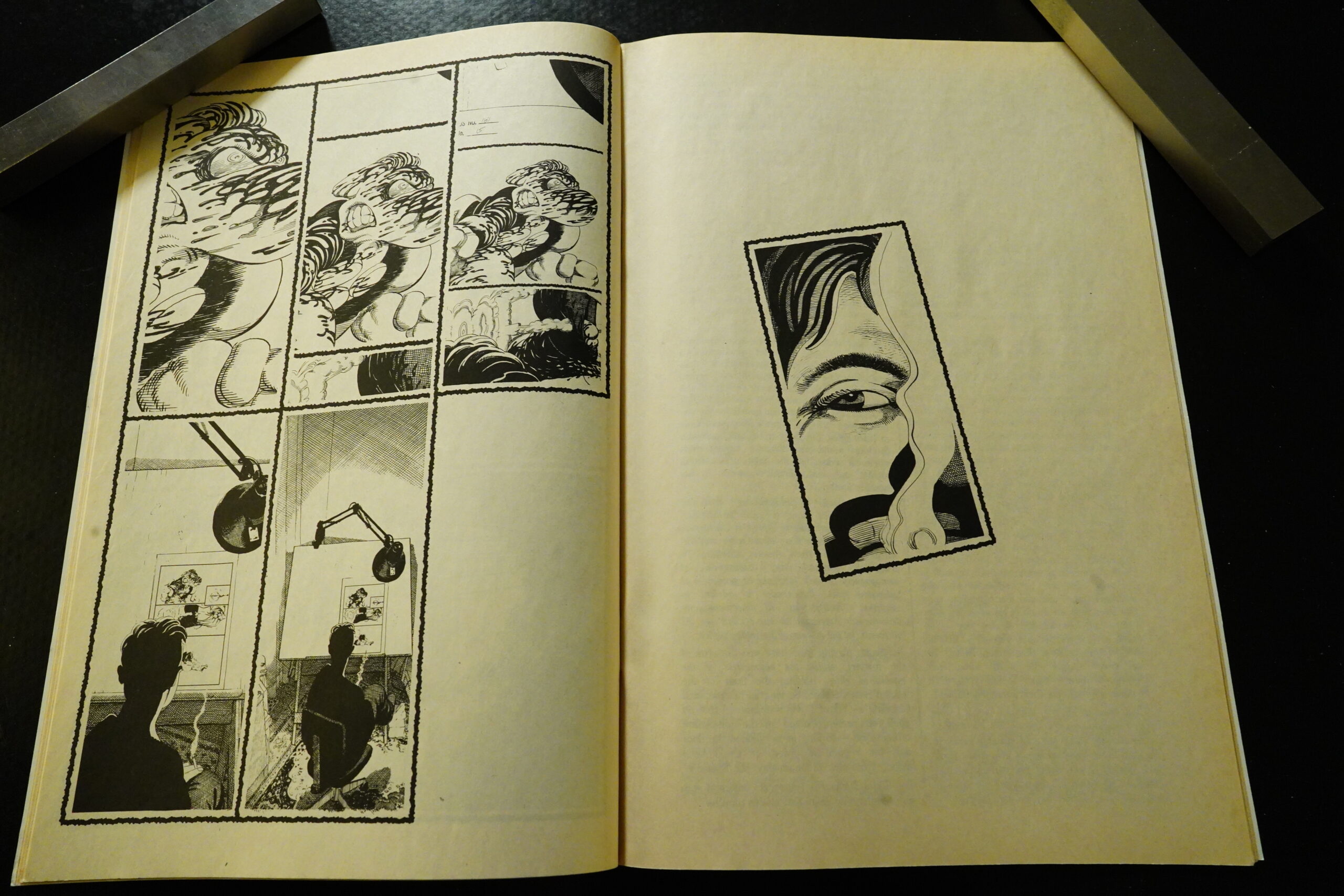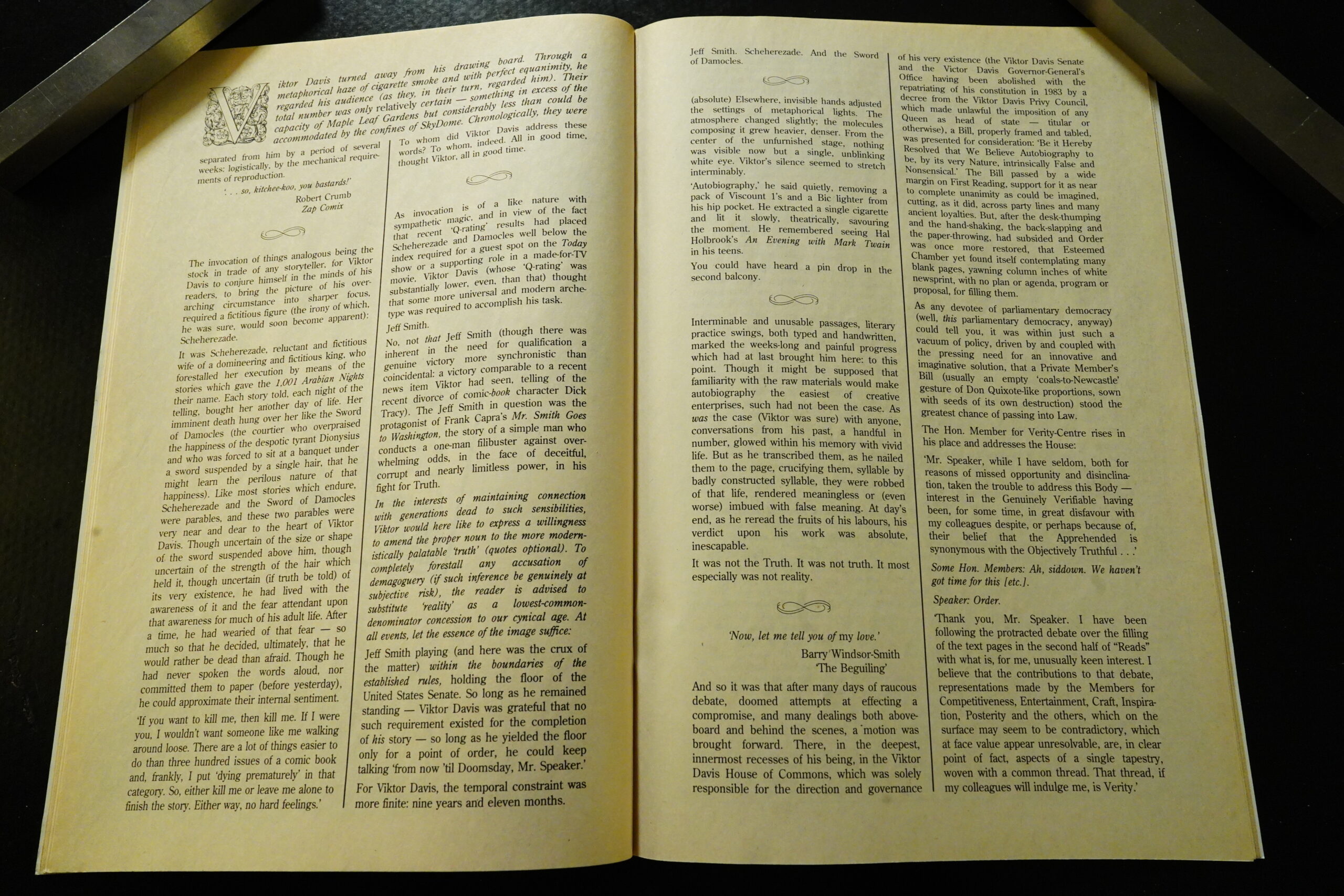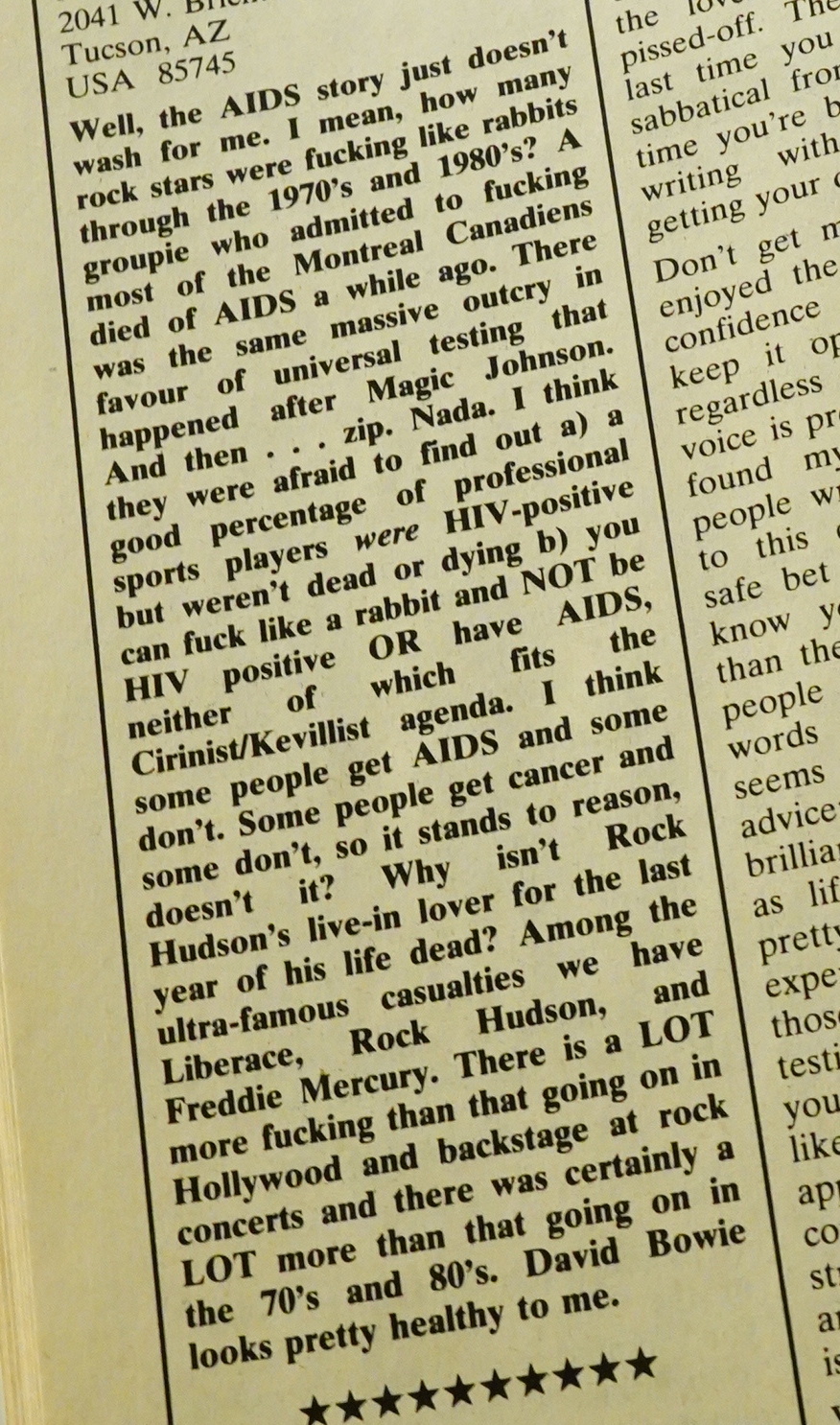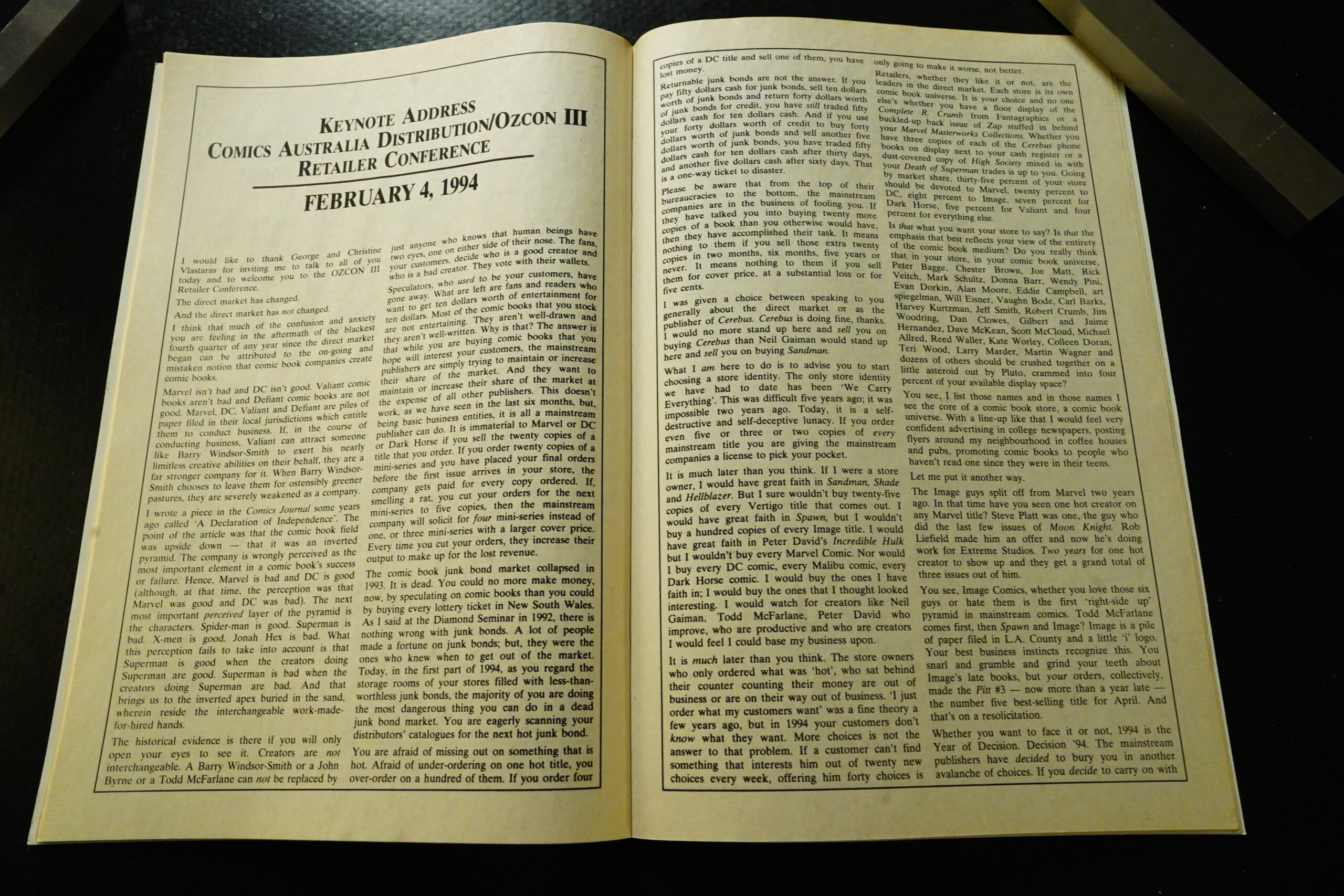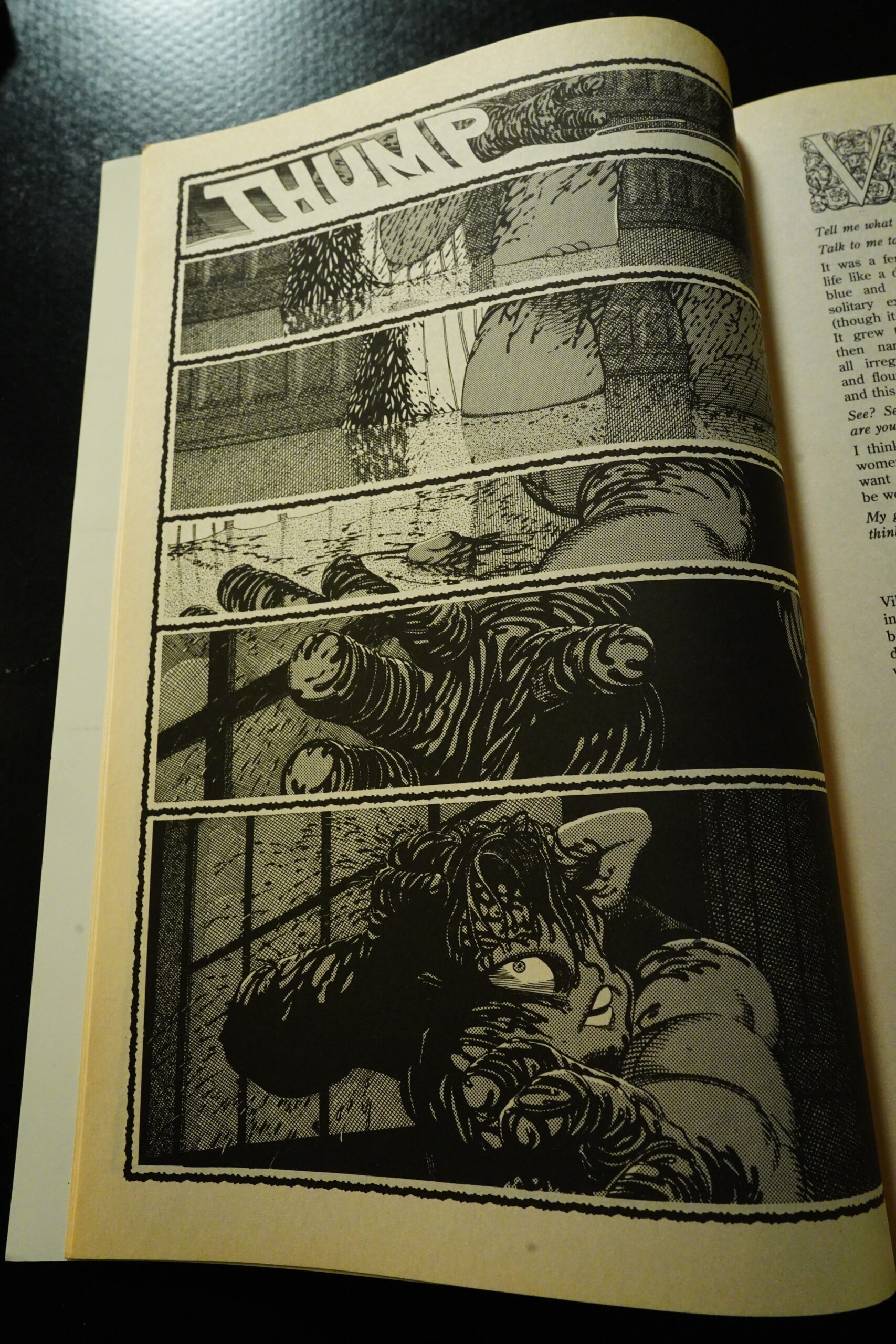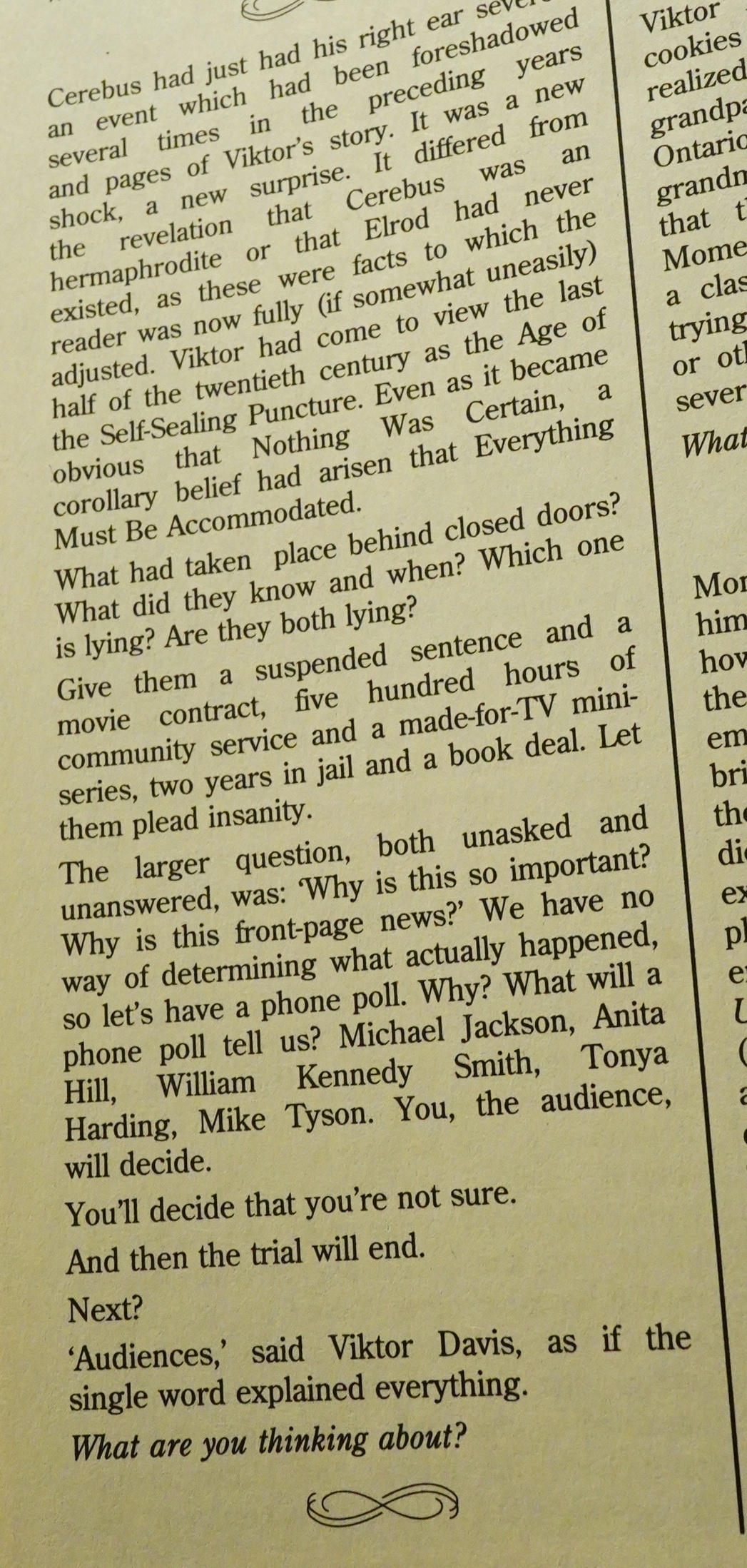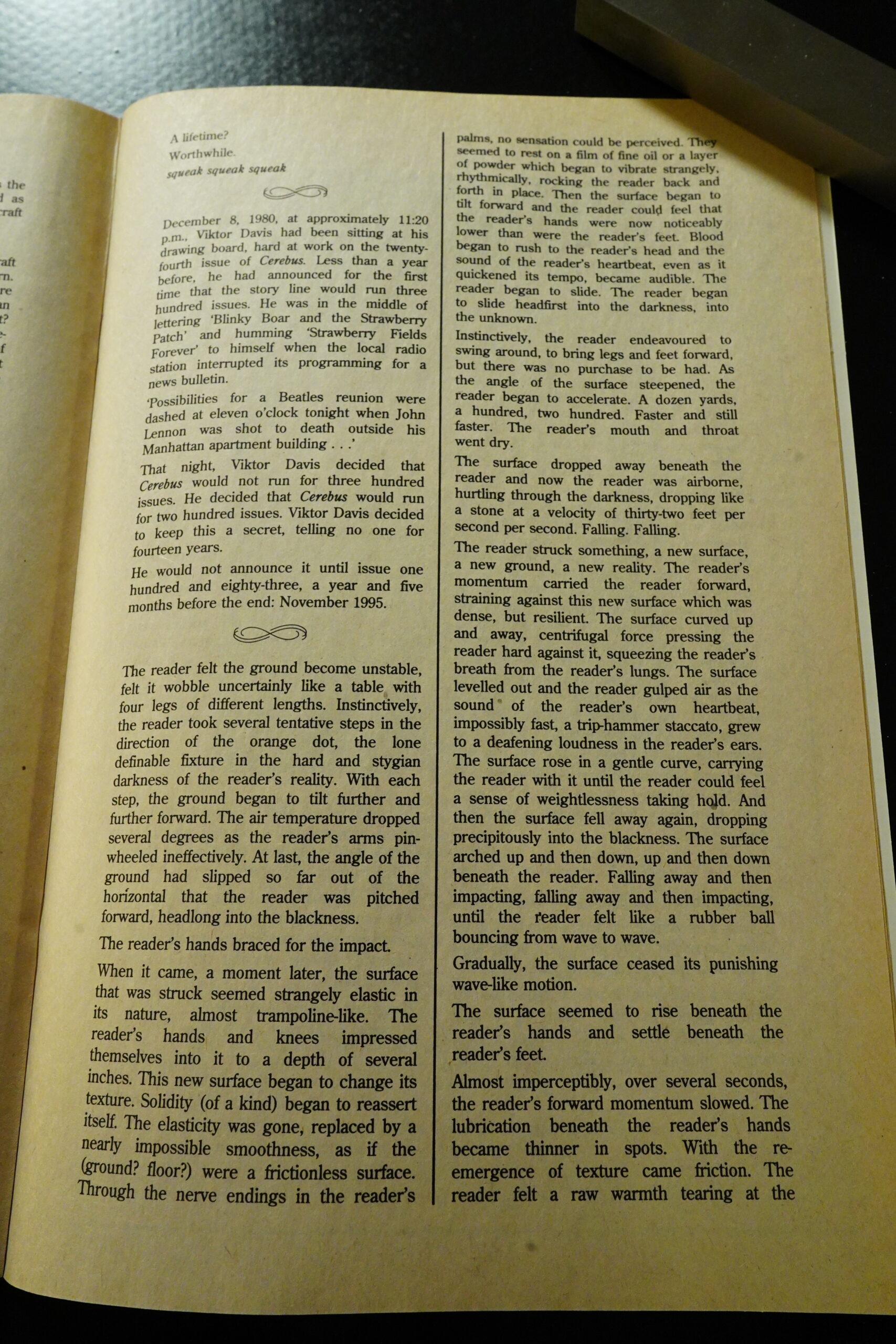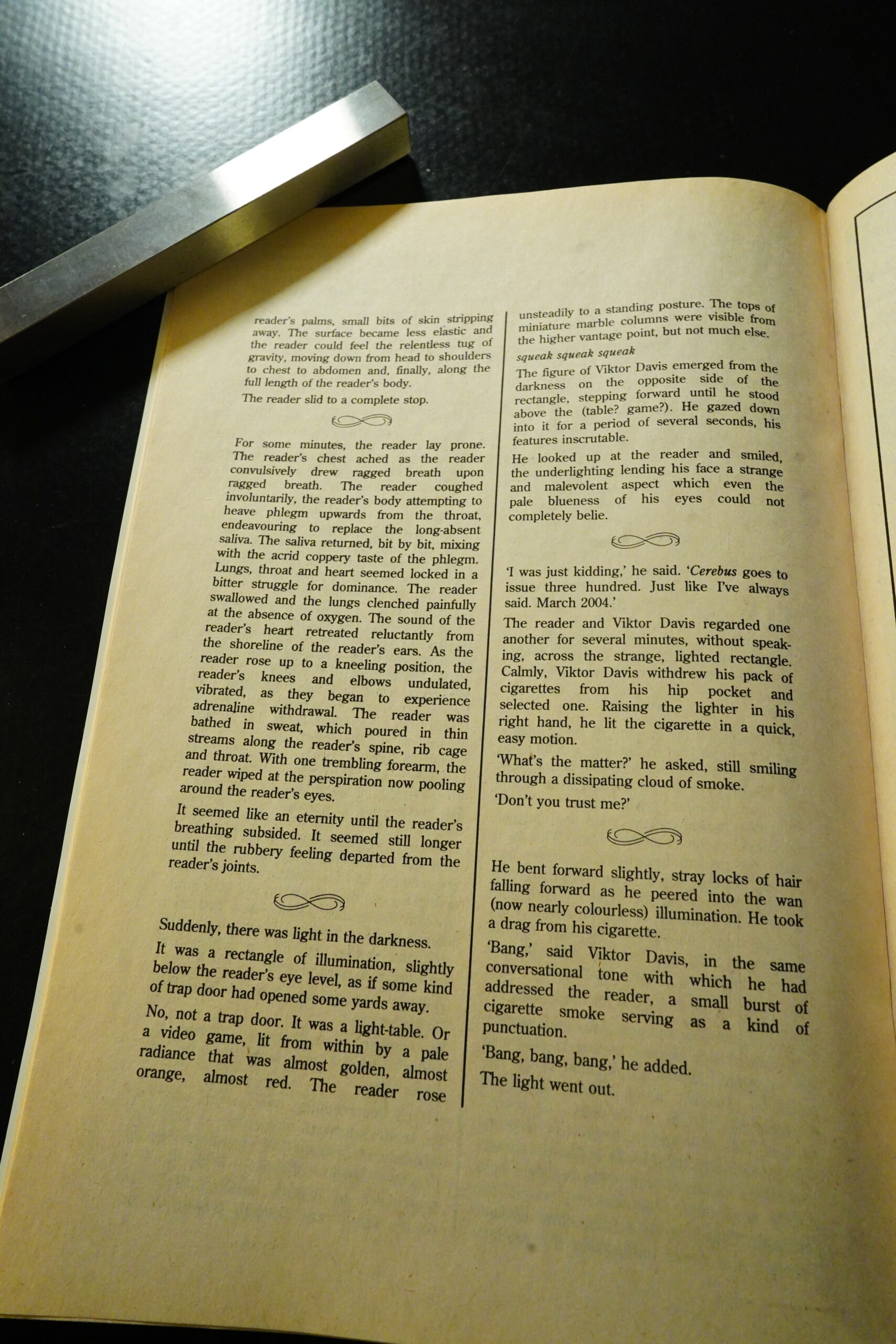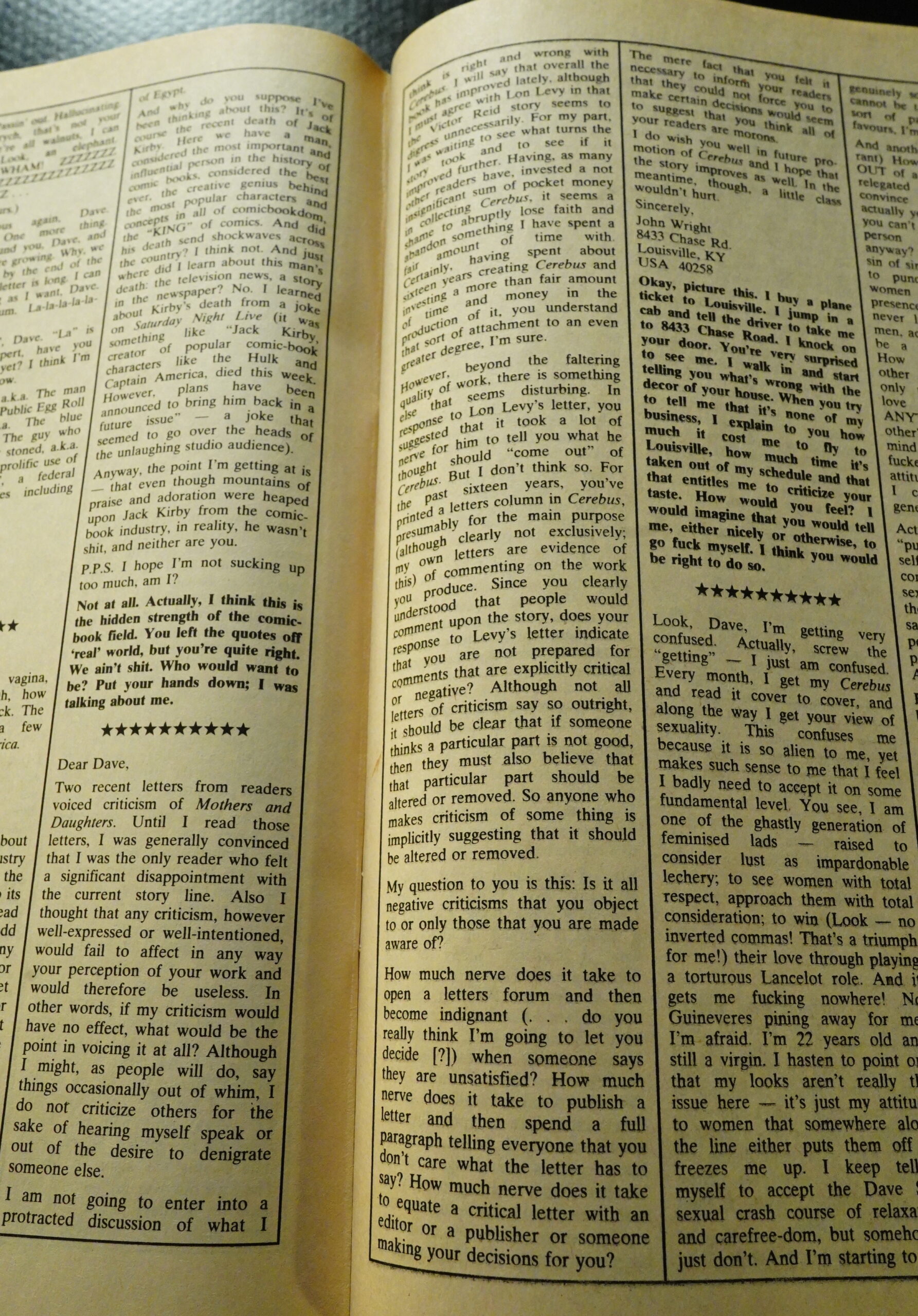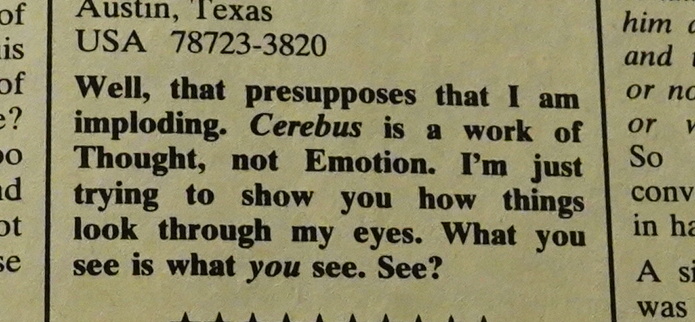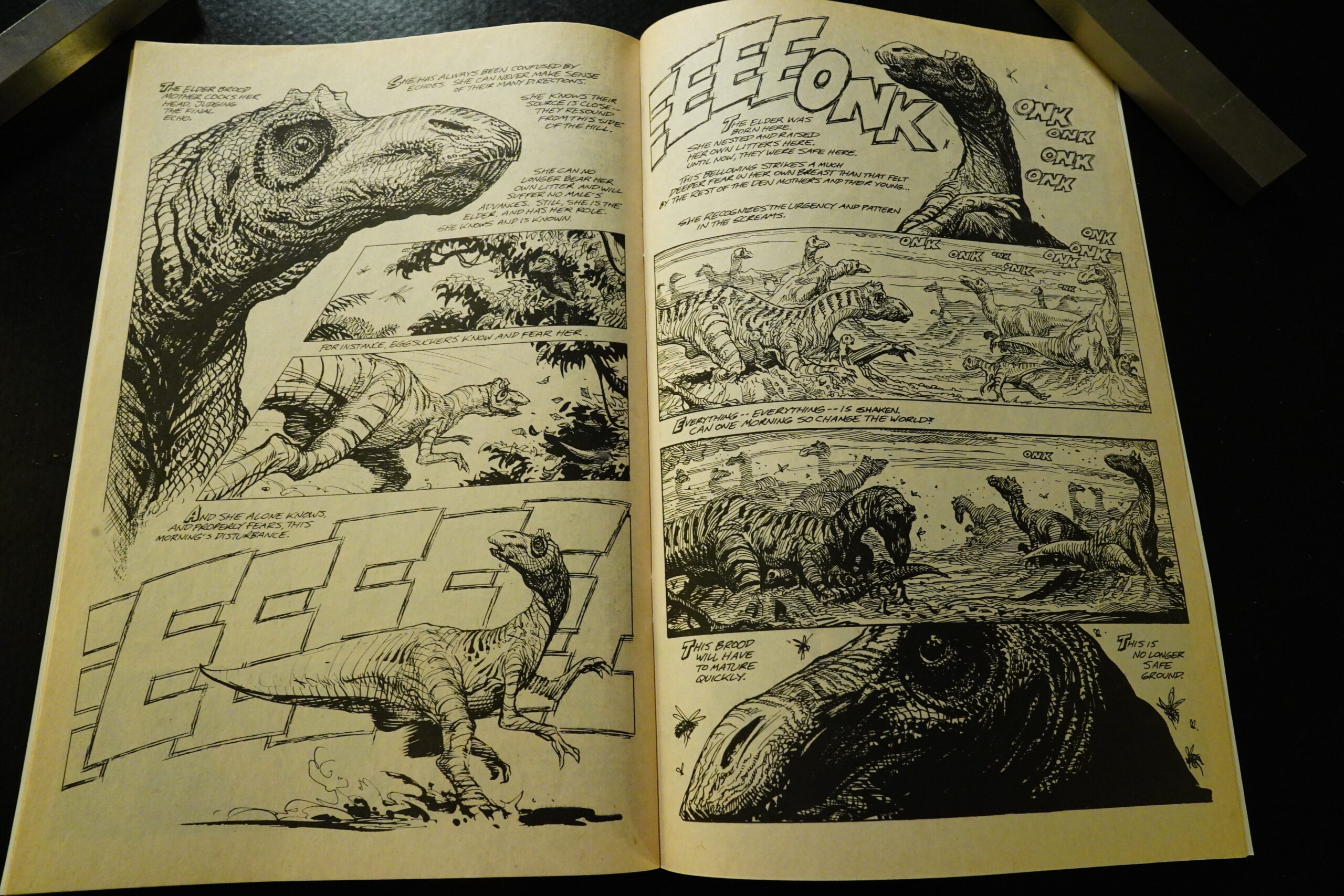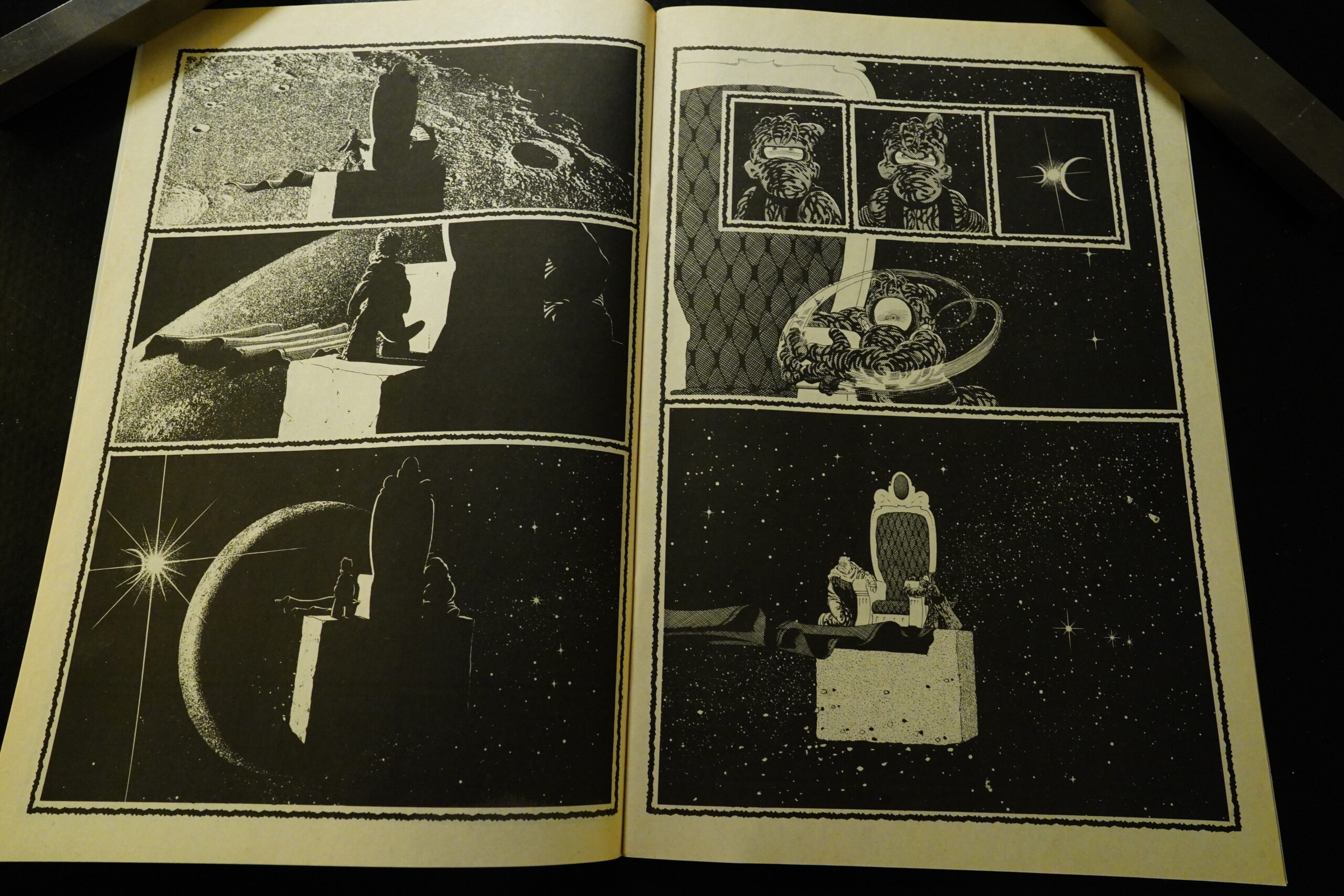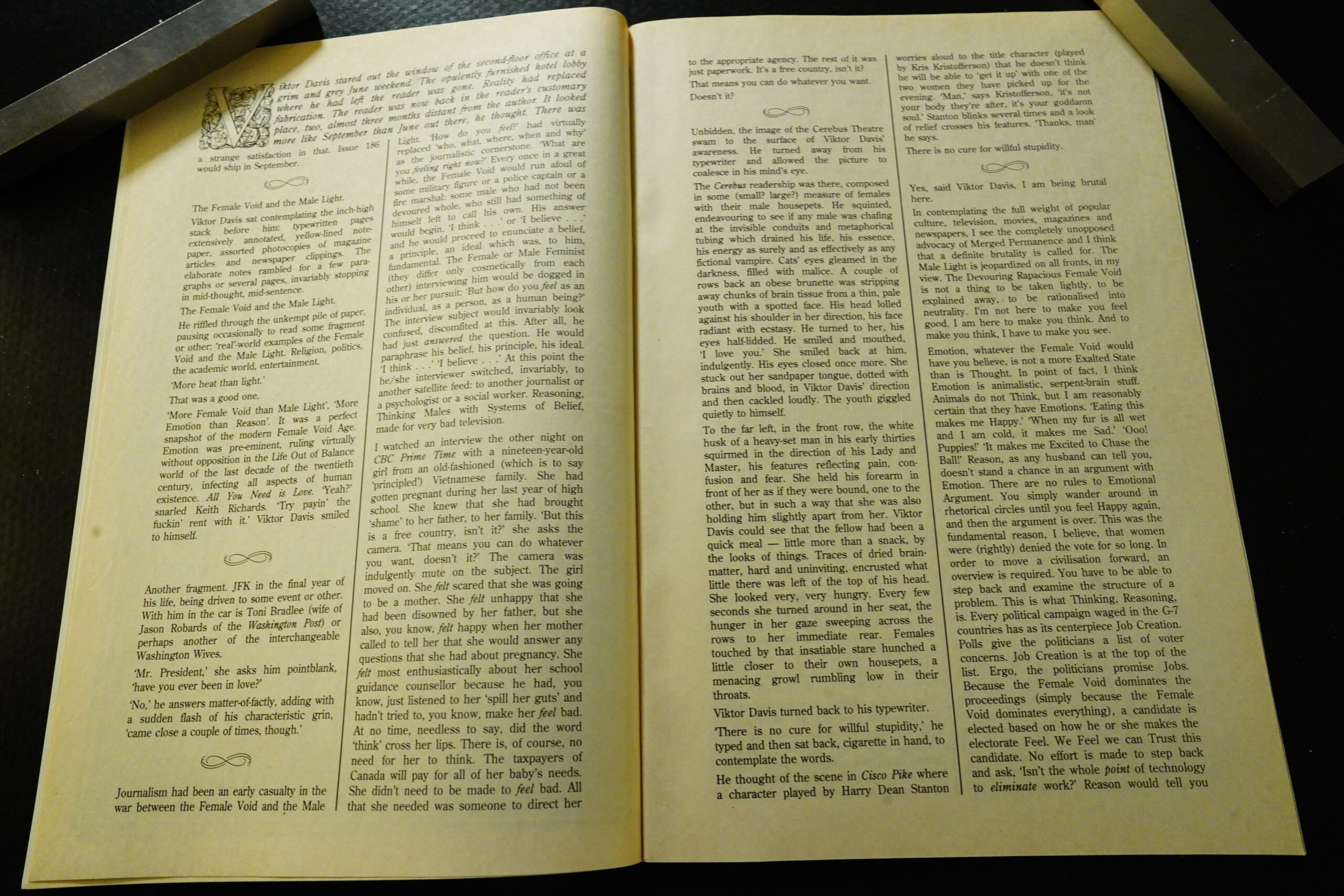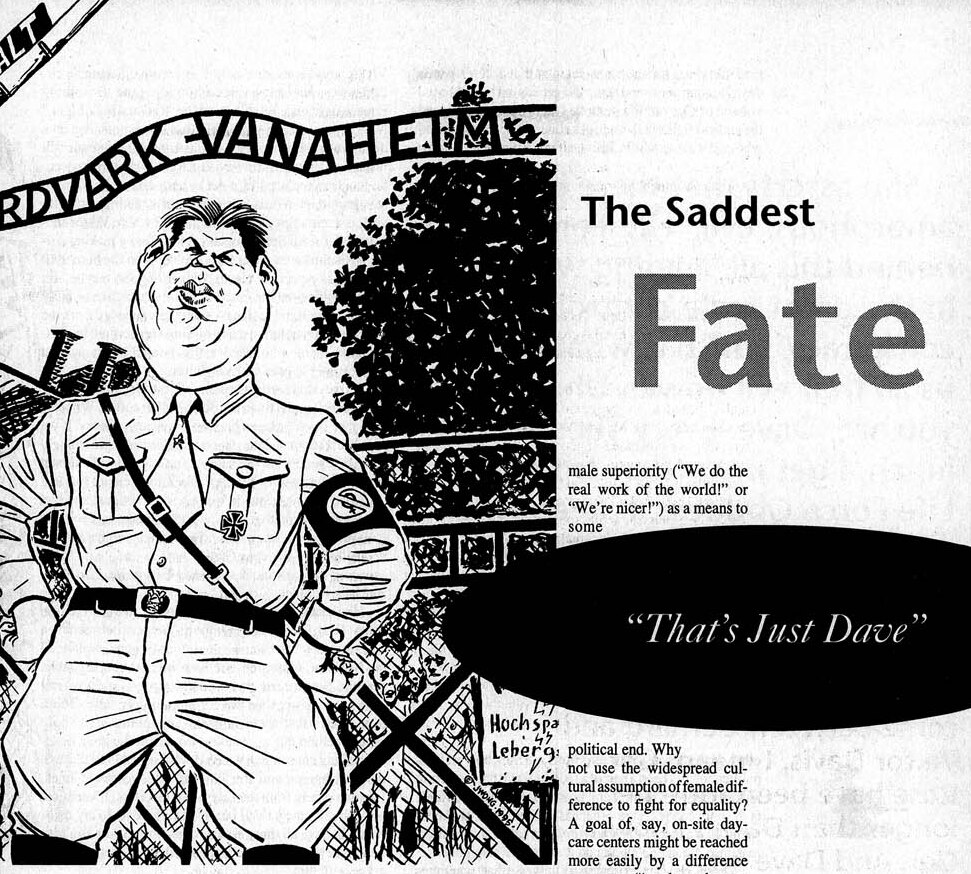Cerebus (1993) #175-186 by Dave Sim & Gerhard
This blog post covers the third Mothers & Daughters book — “Reads”. The first issue here says that it’s going to run for 14 issues, but that’s revised down. I’m not sure whether it’s just a typo here, or whether Sim changed his mind.
“Reads” is a bit of a hodge podge. The first half of “Reads” is dominated by the story of Victor Reid (a name based on Sim’s middle name and his mother’s maiden name), and it’s told in prose. It takes up to 14 pages per issue, which doesn’t leave a lot for the Cerebus story (since we only get 20 story pages per issue).
And the Victor Reid story doesn’t really seem to have much to do with anything. It’s about a writer working in a publishing industry which seems pretty much identical to the American comic business — only producing pulp fiction pamphlets instead of comics. Since Sim (over the preceding year) had gotten really into self publishing, and was travelling around the country extolling the wonders of doing it yourself, it all seems more than a bit like Sim’s day-to-day travails is, once again, taking over Cerebus. And Sim writes in the introduction that he’s already written all the Victor Reid bits before he’s even started drawing the issues, so it means that he’s giving himself and Gerhard a bit of a holiday: Instead of writing and drawing 20 pages per month, he only has to do a handful of pages.
As usual with Sim’s prose, it’s leaden and smarmy.
The text is replete with references to current figures in publishing, and it’s basically about how publishers are bastards, and you shouldn’t deal with them. I think that’s a familiar refrain…
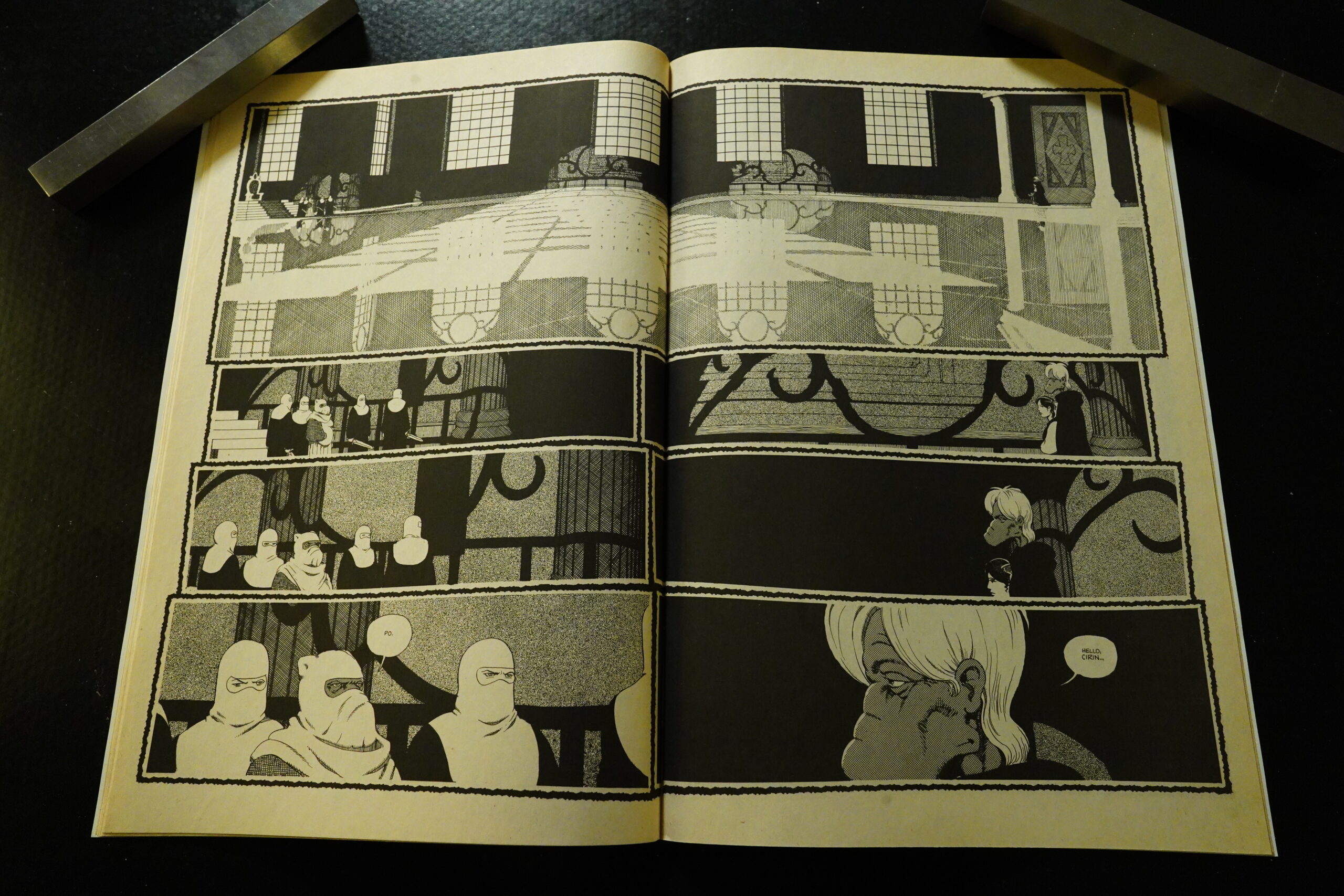
But! There’s more pages left after the tedious Victor Reid bits! What’s happening with Cerebus and people? Well, this.
The issues continue to feature a lot of previews and stuff from other self publishing artists. Here we have a ditty from Colin Upton about a guy that’s so brow-beaten by hip women that he turns into a Nazi or something.
That’s a nice Colleen Doran pic. (She doesn’t smoke or drink.)
The number of issues for “Reads” has been corrected, see?
The Victor Reid text isn’t just about how awful DC Comics is — it also takes a detour into Truman Capote land (I read that unfinished book a few months ago; it’s not very good, either), but it’s pretty unresolved.
In Cerebus land, Suentus Po explains to everybody what’s going on and stuff.
And the lads are in the UK.
Editors are so evil! So evil!
Nina Paley shows up for a few pages…
Heh heh. Sim is so good at these scenes…
See? It’s fantastic.
Wow.
And so the Victor Reid saga comes to a conclusion — in the middle of “Reads”. He suffers the ultimate indignity: Having become rich and famous, with a wife and child, he’s producing works that are a bit on the naff side.
So now what?
Oh yeah, Sim continues his quest to kill off all of the “fantasy” characters.
Sim continues to handle mild criticism in a reasonable manner.
Sim is so taken with Rick Veitch’s new self published book that he runs pages from Rare Bit Fiends three issues in a row.
Once Astoria and Suentus Po leave, Cirin and Cerebus get into it, and this drawn-out fight continues for the rest of “Reads”. It varies how many pages are dedicated to the fight, but it’s pretty epic.
But then… Is that Sim? IT IS
Or Viktor Davis, as the character is called. (Davis is also a family name.) This text has nothing to do with anything, either… at least not in the beginning. It’s a rambling, tedious text.
Sim is now also an expert in epidemiology, I’m sure you’re relieved to learn.
And Sim continues to travel the word, spreading the gospel of Selling The Comic Books.
*gasp* Collectors take note! The first appearance of the new Cerebus design! I.e., with only one ear!
Sure, sure.
And then… Sim reveals that Cerebus will end with #200, and not go on to #300!
Just kidding!
But the thing to note here is what effect Sim imagines this would have on the reader — the world being torn asunder, depression spreading throughout the realm. And not “well, that’s a something. Anyway. What’s for dinner?”
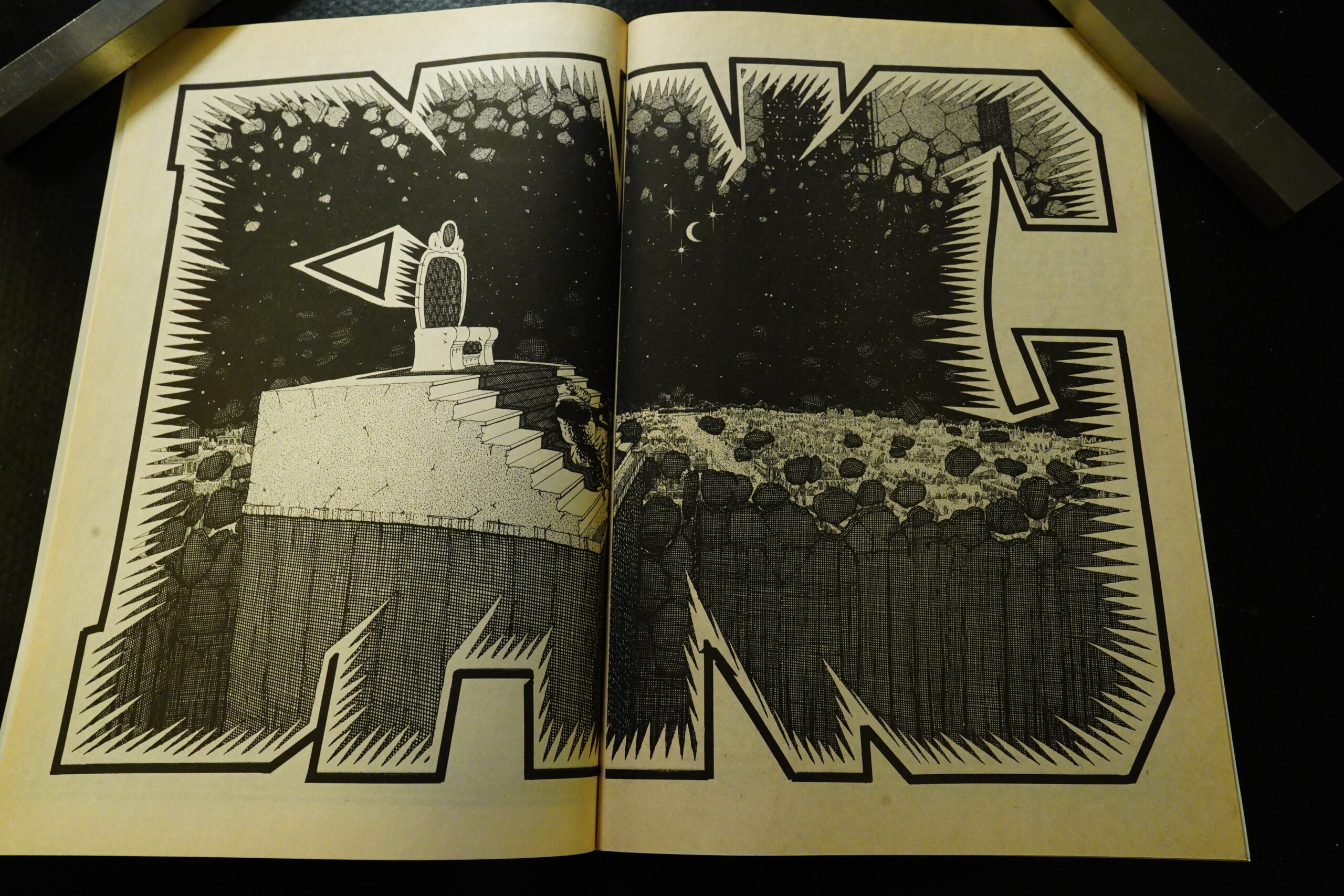
And then! Just when you think there’s been a sufficient number of ascensions, another one happens!
Yes, yes… writing a letter with mild criticism to a comic book is just the same as going to somebody’s house and then start slagging off their furniture. It’s exactly the same thing. ⭐⭐⭐ logic.
What’s the word for when you’re so caught up in your own emotions that you don’t even realise that they’re emotions any more?
Steven Bissette gets two issues of Tyrant previews.
And so the Cerebus bits end…
… and here half of Cerebus’ audience left. In issue #186, Sim explains that men are the Creative Light and women are Irrational Voids.
This didn’t really go over well with people — I guess Sim was ahead of his time, because these days he might well have become a Gamergate Super Star. (Or perhaps not — Sim’s thing would probably be too weird for them.)
Mothers & Daughters
AH: You started to talk about how
“Mothers and Daughters.” is about
birth and rebirth. Do you want to
elaborate on that?
SIM: Not really. One of the difficult
things with talking about the book is
that you can’t really give surprises
away, the problem being that you sort
of have to talk generally, and the more
generally you talk, the less actual in-
formation people are getting.
AH: I ‘II ask a more specific question.
How many issues will ‘Mothers and
Daughters ” run?
SIM: Fifty issues. Just about exactly,
I think, but I’ve been wrong before.
“Church and State” was originally go-
ing to run through issue and then
it was going to run through issue #115,
and then it ended up going through
issue #111.
All: Will it have a lot of Cerebus in it?
SIM: Yeah. I always find that a little
odd because I think the book always
has a lot of Cerebus in it. The fact that
As soon as daughters give bitth,
politicaly they become mothers,
he was just sitting on a chair, clutching
a doll and a sword for a year, to me
there was a lot of Cerebus in it. I think
[when] most people ask that question,
what they’re asking is, “Will he be up
fooling around and stuff?” Yeah, he
does a certain amount of that.
AH: I understand Cerebus will be-
come Pope again?
SIM: Umm, yeah. Briefly.
AH: I felt very torn because on one
hand I want to be completely sur-
prised by the book. On the other hand,
I feel a sort of responsibility to ask for
some sort of preview.
SIM: Heidi McDonald used to run in-
to the same problem phoning about
the Amazing Heroes Preview Special
because it’s not really the sort of book
that lends itself to that sort of preview.
“After their big galactic war, they
come back to earth and rebuild their
clubhouse” sort of thing.
I think I’ve really said all I really
can say about “Mothers and Daugh-
ters.”
Thematically, it is birth and rebirth.
Cirin and Astoria figure prominently
in the story as obviously the most pro-
found mother/daughter type of rela-
tionship. Even though they’re not
blood relatives, there’s no question
they relate as mothers and daughters.
Examining a little bit more of the
distinctions between Cirinism and
Kevilism. Cirinists are mothers and
Kevilists are daughters.
Largely, and this is again something
I see in reality, mothers tend to have
specific characteristics and daughters
tend to have specific characteristics,
and as soon as daughters give birth,
politically they become mothers. They
could have been the most ardent fans
of civil liberties, but the moment they
become mothers, there isn’t a civil
liberty you can’t take away that
wouldn’t make them absolutely deliri-
ous because it keeps their children
safe.
Heh heh.
Anne Rubenstein writes in The Comics Journal #174, page 122:
In Cerebus #181 through #186, however, “Victor*’
becomes “Viktor,” who appears to inhabit the real world
of North American cartoonists and publishers, rather than
the Cerebus universe (in fact, Viktor may be a stand-in for
his creator, David Sim). And it turns out that Viktor/
Victor’ s problems arise not merely from unfortunate cir-
cumstances but from a vast conspiracy of the “Devouring
RapaciousFemale Void” against the ‘Rational Male Light.”
Now, it is just barely possible that this is intended as a
devastating satire on Ayn Rand, assuming that anyone still
reads Ayn Rand. And to envision Rand’ s taciturn, muscu-
lar architect replaced by a geeky cartoonist who Capital-
izes Words (the creator of a talking aardvark,
yet!) is a minor giggle. The bit in #182 where Viktor-the-
existential-rebel defies social convention by making cof-
fee with unfiltered water then leaving it on the burner all
morning is especially clever, if overlong. So maytr Sim
was just riffing on The Fountainhead; in which case, bully
for him. Ayn Rand is an easy target, but to judge from the
Cerebus letter column, many of Sim’ s readers are impres-
sionable teens who need satire’s inoculation against
windbaggy Theories of Everything.
On the otherhard, my editortells me that Sim sincerely
believes this stuff. Even the bit about the coffee. Which is
to say, he has developed his own windbaggy theory. If we
can take it seriously, the general outline is simple enough.
Sim sees gender as the sole explanation for all human
nature ahd human experience. To Sim, men are rational
and good but weak, while women are emotional and bad
yet powerful; creative work, which is male, is a form Of
struggle against femininity. This is an unpleasant but
unoriginal set of ideas: better writers than Sim have
espoused similar notions, including George Bernard Shaw
and Jack Kerouac.
His theory rests on three assumptions, two of which are
loony. First, Sim asserts that the differences between men
and women transcend all our similarities and explain all
our behavior. I disagree, but the point is at least arguable.
Second, Sim asserts that women (always, everywhere)
have more power than men. This is simply false. Third,
Sim asserts that there is some amorphous, evil ‘Life
Force” behind this all, leading women in the great male-
controlling conspiracy, which is what gives us all that evil
power. Uh, right you are, Dave. Every Tuesday at lunch,
I get my orders from the Life Force Goddess. It keeps me
so gosh-dam busy that I barely have time to do my nails.
If you believe all three assumptions, then Sim’ s Big Idea
will make perfect sense to you. If you don’ t, then you can’t
argue with him.
Fortunately , Sim ranges so far afield with his Great Big
Theory of Why Life Sucks that he makes it impossible (I
hope) for the most devout, credulous fanboy to buy much
ofit. Among otherthings, Sim takes credit for recent world
history, as in this passage from #186: “When I put Marga-
ret Thatcher in the book and she was forced to resign by her’
male cabinet a few months later, well, when you’re some-
one like me who… is not intellectually equipped to explain
something away as a coincidence, that can ‘be a pretty
unsettling experience. ” And the sequence ends with a rant
Of the sort that used to give drugs a bad name, with Sim
predicting he will eventually be jailed for his sins against
“the Female Emotional Void Age.” Now, Canada does
have some ridiculous anti-pornography laws, but it has not
banned public displays of paranoia and grandiosity. So
Sim is doomed to the saddest fate that can befall a guy who
yearns to Explain It All to You: he’ II be sniggered at, then
forgotten.
For what it’ s worth, though, he does a bang-up job of
drawing aardvarks. •
I remember being on the alt comics Usenet group at the time, and there was one person who claimed for a couple of years after #186 that the entire Female Void thing was an obvious parody, and Sim would reveal everything to us later. That… didn’t happen, obviously.
J. Hagey and Kim Thompson writes in The Comics Journal #174, page 114:
This revelation occurs in the 186th issue of Sim’s self-
published comic Cerebus the Aardvark. In the midst of an
ever-expanding series of semi- or quasi-autobiographical
ramblings entitled “Reads,” Sim, in the guise of his alter-
ego “Viktor Davis” (Sim ‘s middle name is Victor), deliv-
ered a 15-page text essay that deals primarily with gender
relationships and, as Sim puts it, “The Funny Way Things
Are.”
The main point of the essay is that there exists “Male
Light,” from which all creativity and thinking flows, and
‘Female Void,” from which all that is irrational and
emotional pours forth. There is a battle between the two
which the Female Void is winning, and has been for some
time; the consequences of this are catastrophic, on both a
global and an individual scale. Almost all women are
greedy leeches who prey upon male energy to feed them-
selves. There is now way to change the “Female Voids” or
mitigate their nefarious effect upon the commonweal, so
the rational “Male Light’s” only recourse is to stay as far
away from them as possible, and, in the words of Dr.
Strangelove’s Jack D. Ripper, “deny them [one’s] es-
sence.” (In fact, Sim does at one point us the word
“essence” to describe the male substance in question.) A
justification of — even, call for — misogyny as a philo-
sophical stance, “Reads” comes on like a combination of
a bitter post-breakup barroom rant, biologic conspiracy,
and bizarre male Objectivism (in the Ayn Rand sense of
the term).
“It wouldn ‘t be that big a stretch to categorize “Reads”
as Hate Literature Against Women,” Sim writes coolly
toward the end of his piece, and although Sim’s point in
this context is a narrowly legal one — that his comic could
concei vably be prosecuted under the (admittedly slippery)
laws against hate literature in effect in his native Canada
—it is, on a more general level, a fair description. One irate
reader who wrote in called Cerebus “the Mein Kampfof
comics,” and, with thoughts like these, it’ s not hard to see
why:[…]
Inevitably, the question arose as to whether “Reads”
actually reflects Sim’ s opinions, or whether it is a deliber-
ate, ‘Modest Proposal”-style provocation inserted into
what is, after all, a clearly fictional framework. Given
Sim ‘s spirited defense of the ideas expressed in “Reads” in
subsequent issues (no longer under the flimsy cloak Of
“Viktor Davis”), it was not surprising that, aside from a
few cartoonists who didn’t know Sim or Cerebus well and
thus had no opinion, practically everyone agreed that
he’s off his rocker— and there have been a few, within “Reads” wastobetaken literally, as a statementoffaith—
Cerebus’s letters columns—these people, by and large, including Sim’sco-illustratorGerhardandhisclosefriend,
have not included any of his fellow cartoonists.
Dark Horse editor Diana Schutz (who, as a favor, has been
Wethoughtitwouldbeinterestingtocontactanumber proofreading Sim’s work for years, including “Reads”).
Reservations were mild: Alan Moore suggested that Sim
might be overstating his case ‘ ‘to help others understand
their position,” and Hepcats creatorMartin Wagner floated
the possibility that the view ‘ frnay have been his at the time
but may not be now.” Naughty Bits creator Roberta Gre-
gory commented that “his views are so extreme that his
readers must wonder ifhe’s serious or trying to be funny,”
and speculated that “with his ‘Viktor Davis’ persona he
may be trying to step outside and examine these ideas.” In
fact, Omaha the Cat Dancer writer Kate Worley pointed
out that “it’s hard to confront Dave directly because it’s
cast in a semi-fictional form,” but quickly went on to say
that she found this “particularly revolting — because it
gives too easy an out.” Still, it doesn’t appear to be an out
that Sim is inclined to take, and “Reads” can thus be fairly
taken as a genuine position paper on Sim’s part. In fact
there’s an element of evangelical fervor in the tone of the
piece: at one point, Sim reflects wistfully, ‘ ‘Would that he
could conjure a podium, a venue, and assemble all the
creative Male Light in one place.”
You can buy the entire issue of The Comics Journal here (or rather a subscription to the archives). There’s a bunch of articles on “Reads”.
The Comics Journal #192, page 82:
I knew if I
could get past Reads — and given the ubiquity and
portrayed malignance of the Androgynous Main-
stream, I put the odds at about 70/30 in åvor Of
Cerebus being allowed to exist after #186 — that
Cerebus and I were going to have a little chat.
Yes, that was a real worry, eh?
The Comics Journal #192, page 77:
SAJRGEON: Moving into #186…
SIR Okay.
SPURGEON: Let’s talk about the structure/approachfirst, as
far the style. War that a choice based on the type
of material you were presenting?
SIN: Yeah. In the limited amount of space, there were a
lot orthings I had to cover. The same decision I made
early on: the staccato effect that goes on throughout
Mothers and Daughters. You’re seldom in one place for
more than one or two pages. I’ll showyou this over here,
and I’ll show you this over there, and this over here;
sketching the parameters, discussing women. Again,
they’re very subtle creatures, and it’s much easier to
sketch the parameters ofsomethingyou’re doing rather
than to start at the beginning and “Here’s how we’re
going to deal with this in a logical and sequential
fashion.” The subject just isn’t amenable to that.
SRJÄGEON: You aren afraid Of using material
that spoke to a h mired number Of people in your audience.
At the same time, this is the central idea Of your work…
Oh, definitely. The end of#186 is very much the
eye in the pyramid, the summit of the mountain… or
the deepest part ofthe pit, depending on which picture
suits your own view having read it.
SPUQGEON: We had a switch between two Oscars, now we
have a switch between That planned?
SIN: Oh, yeah. That ties in with throwing in Suenteus
po in the course of Flight, and the chess game that
continues through Women, setting up a false Dave for
Cerebus to have to deal with. In examining the totality
of the Cerebus project, all 6000 pages, there are really
three parts to the equation: There’s Cerebus, there’s
me, and then there’s the person reading it. There are
those three individuals. Five people are not going to sit
hunched over a copy of Cerebus reading it simulta-
neously. It is those three individuals. So what I was
doing was bringing those three individuals as close
together as I possibly could. I was dealingwith Cerebus
through Flight and Women, setting up a stand-in Dave
for him to consider and deal With and — through the
course of the text pieces in Reads setting up a stand-in
Dave for the reader to consider and deal with. Here’s
a stand-in for the first halfofReads: Victor Reid. Is it
Dave or isn’t it Dave? Just as Cerebus is wondering, “Is
it Taritn. or isn’t it Tarim?” Victor Reid — my middle
name coupled with my mother’s maiden name —
mirrors a series of incidents and attitudes and failings
that I see in myself, looking back over 30 years of
conscious existence. A scrap from my 20s, a scrap from
my 30s — my wry observation on the nature of
biography where a handfill of bits of information are
extrapolated into an “accurate” word-portrait of a
hunian being. All of Victor Reid’s personal experi-
ences happened to me, in one form or another, some-
where in my life. On the professional side, it was
“there, but for the Grace of God, go l.” All of my
awareness of the horrors of freelance existence I’ve
gotten from other creators in conversation and from
observation that I’ve been able to bypass for almost two
decades as a self-publisher. All of the pitfalls and cul de
sacs and slapstick that makes up that freelance exist-
ence.
The Comics Journal #218, page 115:
SPURGEON: Is there anything you can say about it now?
SMITH: Sure. There’s not much to tell. A lot Of it was
based on Dave’s infamous Cerebus #186 where he
published his little a tract” about women sucking the
life blood out of men, and how they can’t “think, ” they
can only “feel.” He put Vijaya and I into that issue.
That was unacceptable to me. He was crossing a line
that he’d been warned not to cross.
SPURGEON: He talked to you about it beforehand?
SMITH: He was writing about the time he came out to
California to staywith us during the firstA.P .E. show.
The night he arrived, Dave sat down on the couch
opposite us and said, “Let me tell you what color the
sky is in my world.” Then he proceeded to lay out this
horrible, upside-down, conspiracy-theory view of the
world. Vijayaandlsatthere,andatfirstwetalkedwith
him about it. We were like, “Wow. You almost have a
point, sort of, but Ws upside-down there at the end.”
And he goes on for hours! Droning on and on…
SPURGEON: Dave can talk.
SMITH: Now I know what it must’ve been like to
be trapped in Waco listening to David Koresh!
Vijaya and I were rocking back and forth, going,
“Can we please go to the bathroom now?” I’m
making light of it, but it yeas really offensive
stuff, and there was no arguing with him. Finally
I said, “Dave, ifyou don’t shut up right now, I’m
going to take you outside and I’m going to deck
SPURGEON: Really? Wow!
SMITH: It was that serious. Well, he shut up.
There was dead silence, and he squinted his
eyes. He took a drag off his cigarette, and that
was it. We went on with our weekend and
forgot about it. At least I did. He wrote about it
in Cerebus#186. But in his version, instead ofme
threatening to give him a fat lip, he has me
fawning and begging him not to reveal the true
evil secrets ofwomen in front of Vijaya. [Scared
voice] “Dave, stop giving away the secrets ofthe
universe! Please! Stop giving them away! get
in trouble with Vijaya!” And Vijayais portrayed
like a scheming Mata Hari, when really she was just
angry and bored. [Laughter] I was in Japan a couple of
years ago, where Vijaya and I spent a week with Jules
Feiffer. At the end of the trip we were at a nice dinner
and Jules was asking me about the self-publishing
movement and Cerebus #186. Ofcourse I told him the
story, and we laughed. He said after spending five days
with me, I just didn’t seem like the same kind of guy
Dave had put in his book. Anyway, to finish the story:
To add insult to injury, on the back cover of Cerebus
#186 Dave listed the Spirits of Independence tour
dates and locations. None of which had been agreed
On. The Spirits tour was something we had come up
with — me, Larry Marder , Dave, and Martin Wagner.
We’d been working on the tour for a year and a half,
and we were supposed to get together later that month
and decide when and where it was going to be. But we
were having a struggle over whether it was about self-
publishing or whether it was about creators. I wanted
to include people like Mike Allred, and Peter Bagge,
and Frank Miller as well as self-publishers. My whole
deal was about creators who Steer their own ship. Still
is. Dave’s whole thing was it has to be self-publishing.
He got real aggressive about it, and decided that the
rest ofus didn’t really need to go on the tour. [Laughs]
So the whole thing wasjust like… I just had it. I just
had it. You guys are going around and telling people
they’re going to get rich, be the next Bone. And that
was just not true. And the whole thing… I didn’t want
to have anything more to do with it. Dave got the tour
to himself.
OK, I guess that’s enough of the contemporaneous reactions to “Reads” and #186…
The controversial sections of Reads are a pretty small fraction of the full 300, and even if I don’t agree with all of it, at least it’s written well.
True:
The prose bits go incredibly slowly, making this a turgid crawl to get through. The comic bits go so quickly that they account for maybe 5% of your reading time. Those parts still show Sim’s strengths; the guy can really write/draw a riveting, ultra-slowmo action sequence. But that accounts for so little of the volume that it’s not enough to save it.
Like with “Women”, very little happens in this book. “Women” could be summarised as “they move across the city”, and this one is “and then Cerebus and Cirin ascend”. But there was a lot of backstory being filled in in “Women”, and it had Swoon, so it was funnier. “Reads” is just a pretty turgid book.
This blog post is part of the Renegades and Aardvarks series.



